

Boost in Mexico’s International Tourism: A Positive Start to 2024
- March 12, 2024
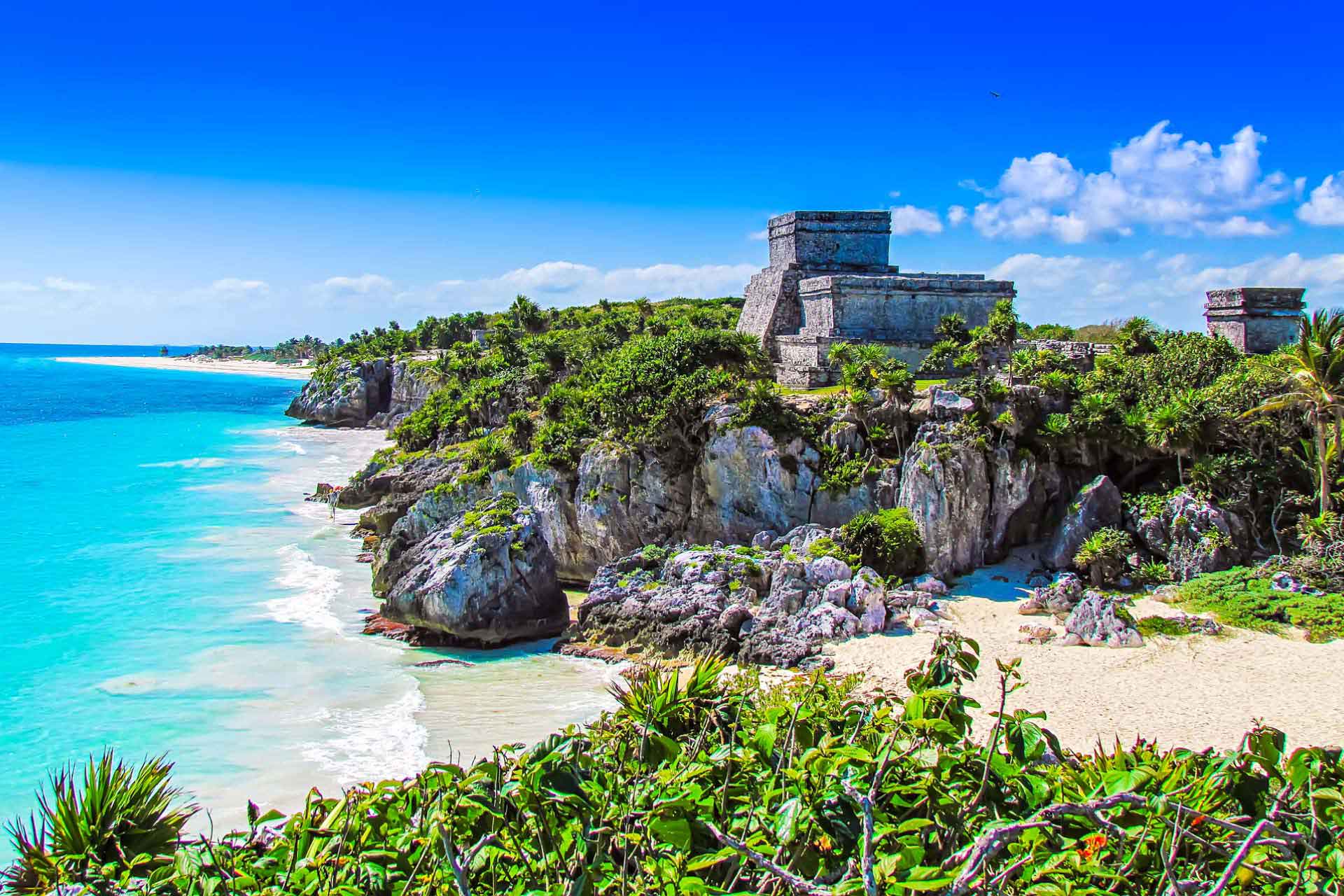
MÉXICO » News » March 2024 » Boost in Mexico’s International Tourism: A Positive Start to 2024
Published by Forbes Staff on March 11, 2024
Mexico has witnessed a promising start to the year in its tourism sector, with a 3.6% increase in international visitors in January compared to the same month in 2023. The National Institute of Statistics and Geography ( INEGI ) revealed that the country welcomed 3.63 million foreign tourists in the first month of 2024, marking an improvement from the 3.51 million tourists recorded in January 2023.
The significant rise in tourism was particularly notable among border tourists, who saw a 6.1% increase year-on-year, totaling over 1.25 million visitors in January 2024. Air travelers also showed a healthy growth, with a 3.4% increase, bringing the number of arrivals by plane to 2.38 million.
Financially, the impact of this growth was substantial, with total spending by international tourists climbing by 4.6% year-on-year to reach $2,940 million in January, up from $2,810.6 million in the same month the previous year. Moreover, the average expenditure per tourist also saw a slight uptick, rising 1% to $808.2.
These figures underscore the continuing upward trajectory of Mexico’s tourism sector, which has been on a steady rise. In 2023, Mexico attracted 42.15 million international tourists, marking a 10% increase from 2022, and generated $28,682.6 million in foreign exchange income from international visitors, nearly 9% more than in the preceding year.
The tourism sector’s contribution to the Mexican economy is also on the rise, with the tourism gross domestic product (GDP) growing by 7.8% annually in the third quarter of 2023. This growth is largely fueled by the services sector, highlighting the increasing economic significance of tourism in Mexico.
Mexico’s position as the sixth most visited country globally in 2022 can be attributed to its flexible health measures in tourist areas during the Covid-19 pandemic, which played a crucial role in maintaining the flow of international visitors despite global challenges.
These developments indicate a robust start to 2024 for Mexico’s tourism industry, reflecting the country’s appeal as a premier destination for international travelers and its effective strategies to attract and accommodate visitors. The ongoing growth in tourism numbers and expenditure points to a positive outlook for the sector, contributing significantly to Mexico’s overall economic health.
Link to the article
More Recent News about Tourism in México
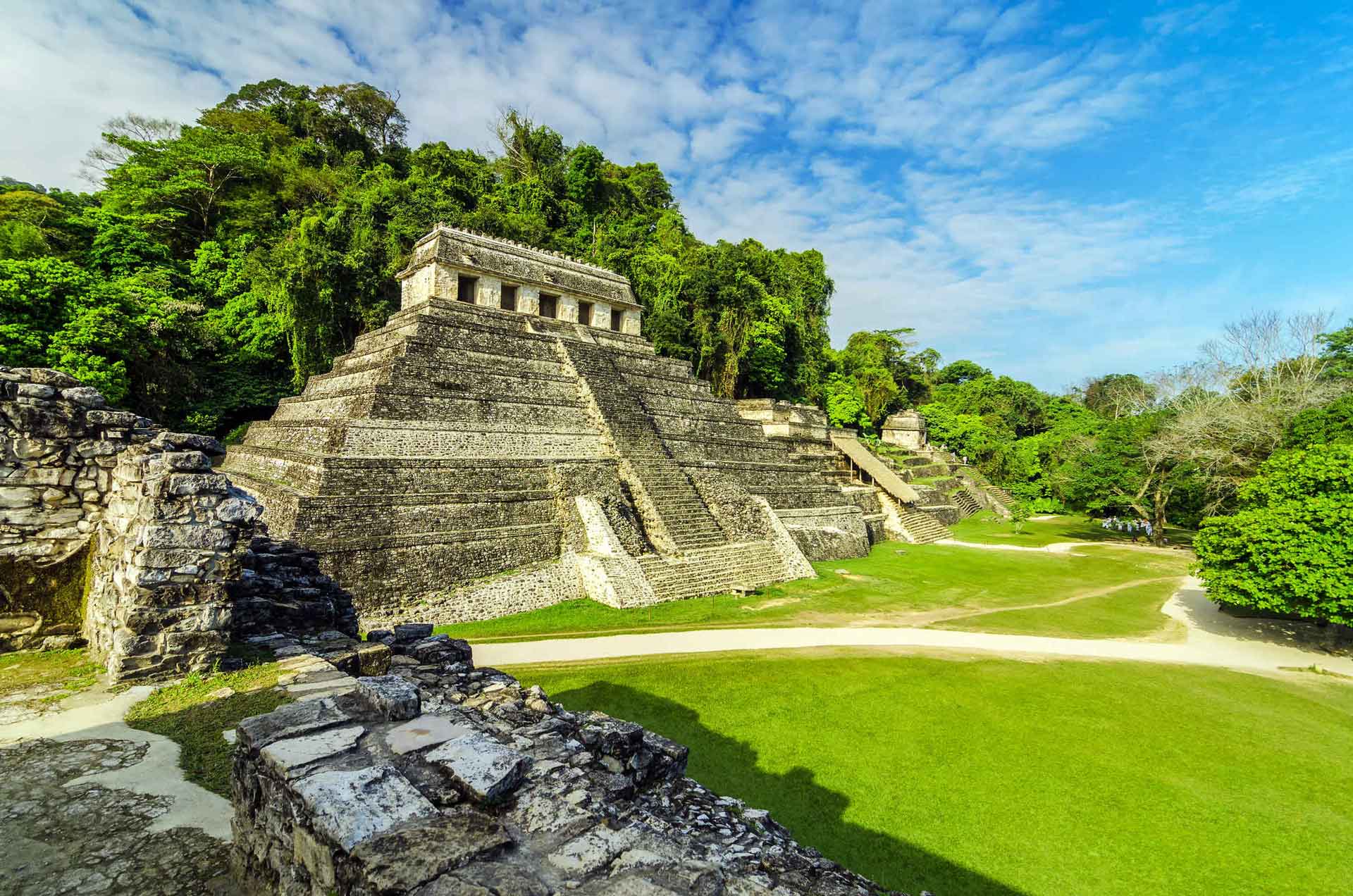
Mexico Ranks Among Top 10 Global Tourist Favorites
Mexico has secured its position among the top 10 most favored tourist destinations worldwide, according to official figures from the Secretariat of Tourism (Sectur), reflecting robust growth in various tourism indicators such as foreign direct investment, visitor spending, and international traveler income.… Read More
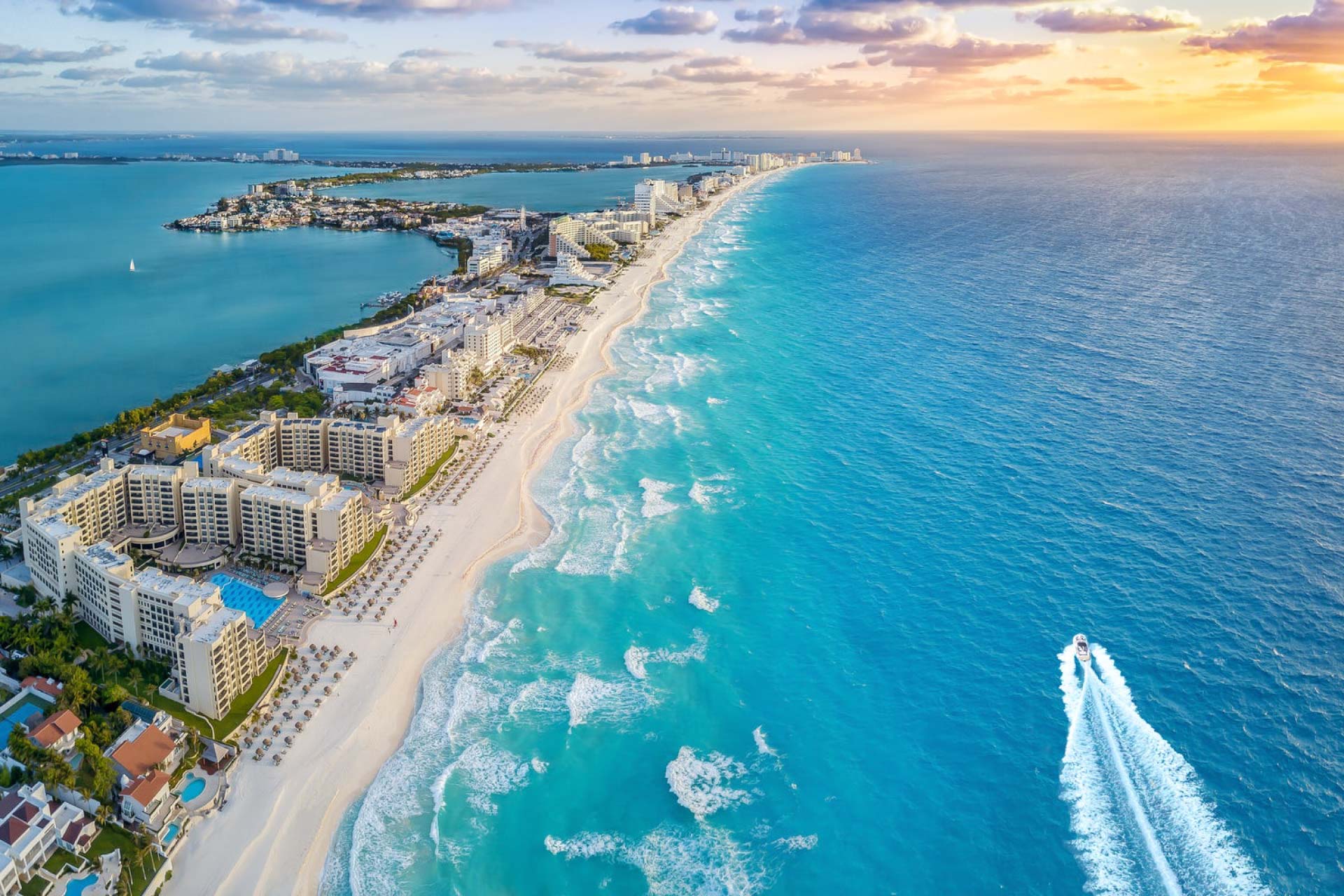
New Italy-Cancun Route Boosts Tourism in Quintana Roo
Governor Mara Lezama Espinosa recently unveiled plans for a new air route linking Italy and Cancun, operated by the Italian airline Neos. Commencing on December 22nd, Neos will operate direct flights from Italy to Cancun every Sunday.… Read More
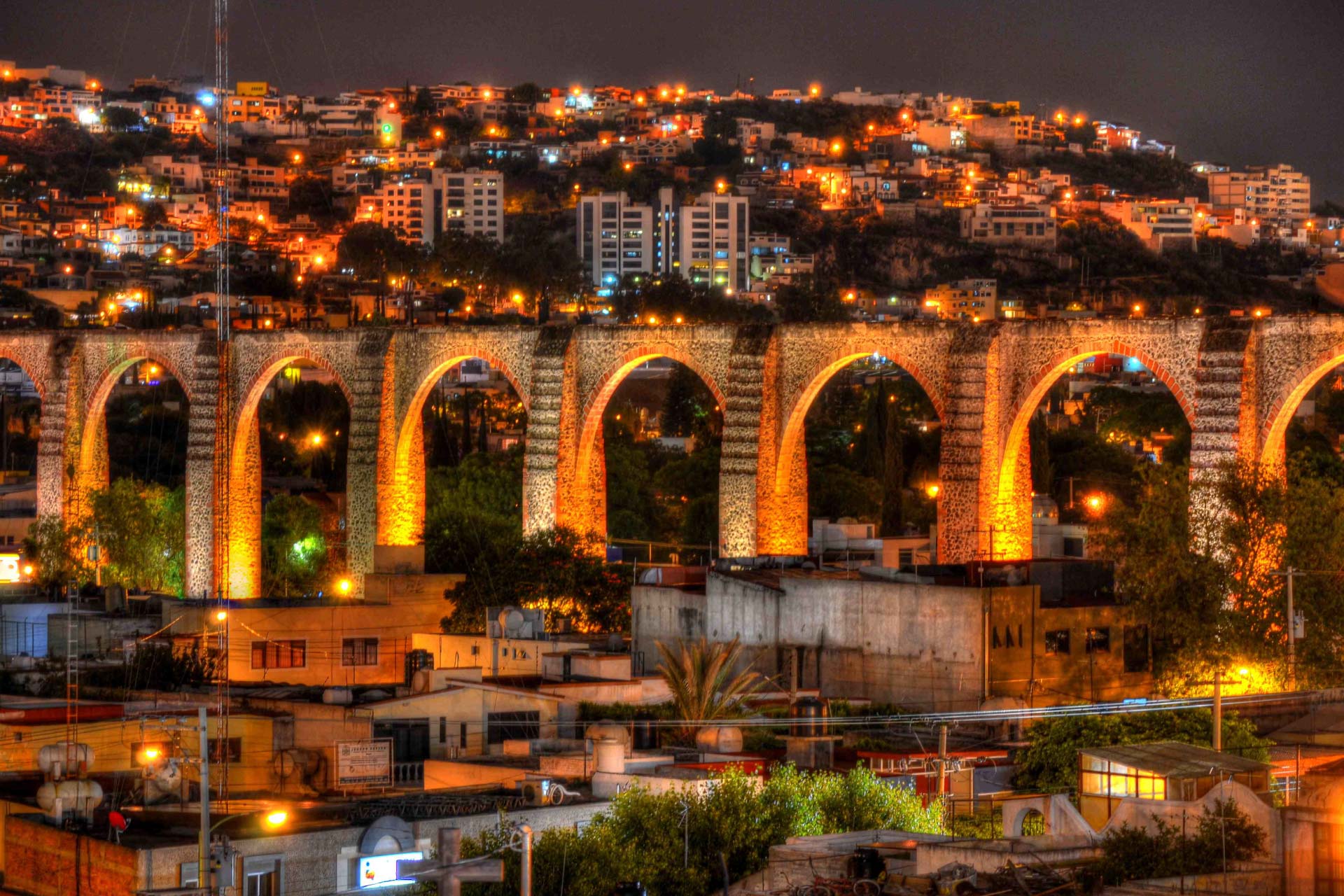
Thousands to Participate in the Xtrail Deprivé Challenge at Bernal Vineyards
Celebrating a decade since its inception, the Xtrail Deprivé Challenge emerges as the foremost national race, set to witness the participation of two thousand runners across the picturesque vineyards of Bernal.… Read More
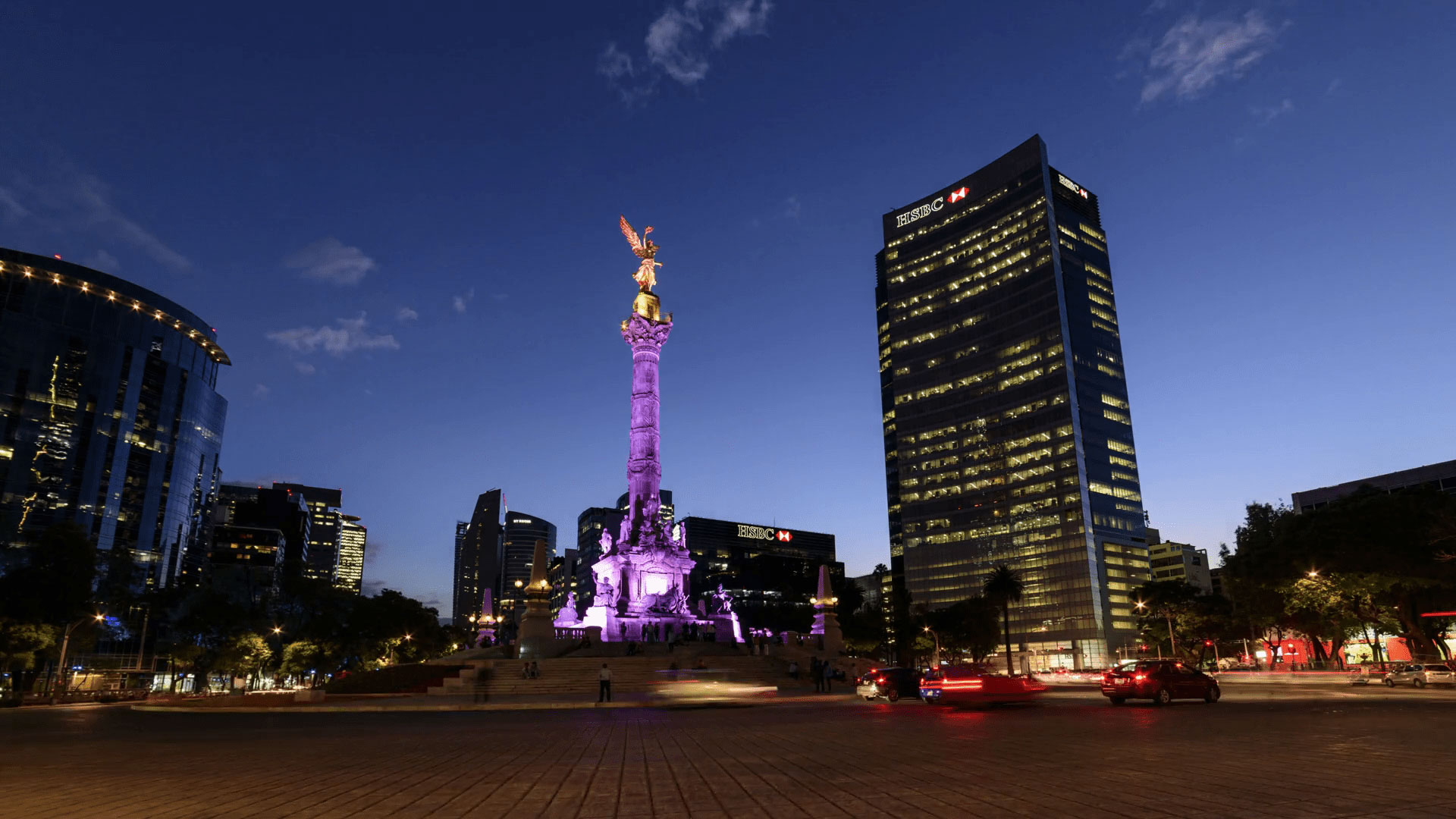
Mexico Sees Decline in Tourist Currency Attraction
In 2023, Mexico experienced a notable setback in its quest to attract tourist spending, slipping five places in the global ranking for foreign currency collection compared to the preceding year. According to the latest data from the UN Tourism, Mexico landed at the 15th spot, despite amassing a historic sum of 30,809.5 million dollars in tourist revenue.… Read More
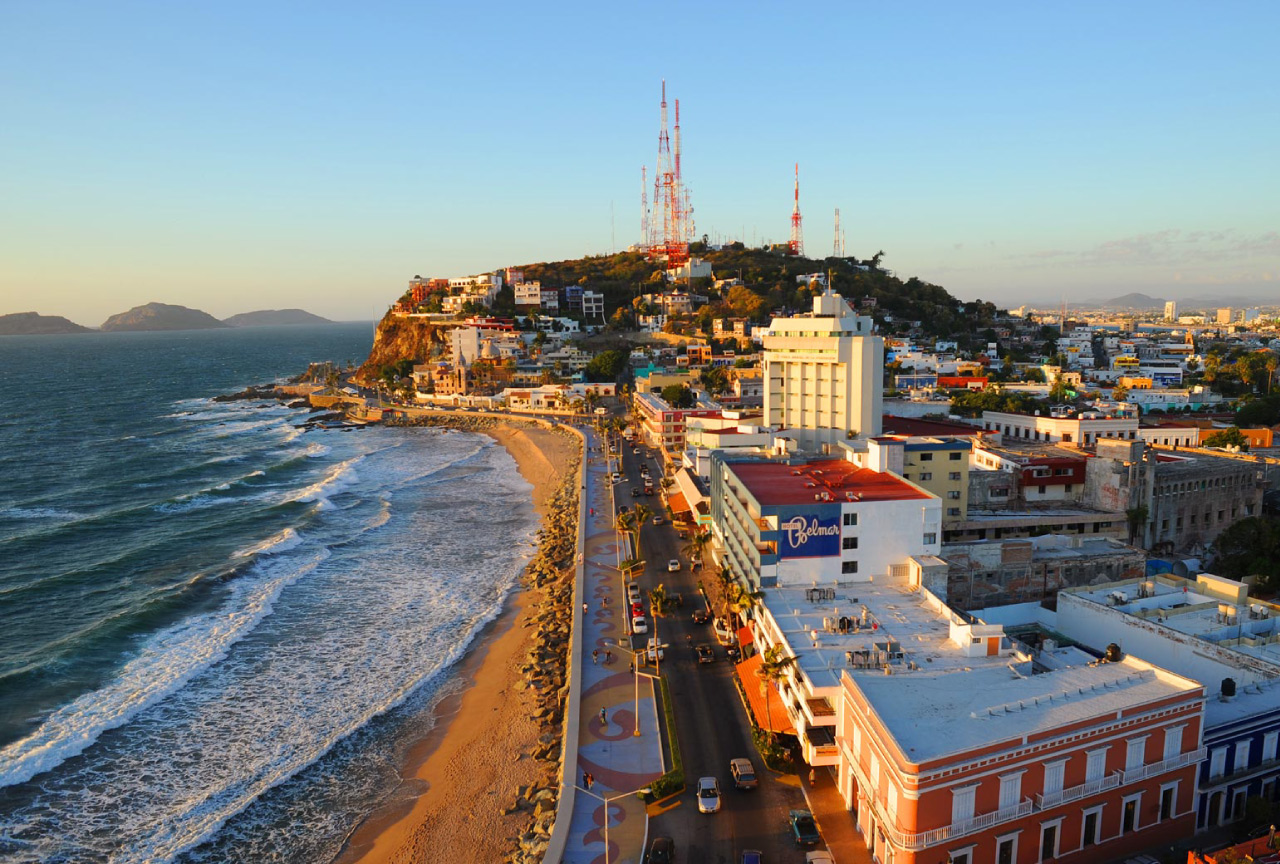
Mazatlán Experiences Surge in Visitors
Ricardo “Pity” Velarde Cárdenas, the head of the Ministry of Tourism in Sinaloa, has highlighted a notable increase in visitors to Mazatlán over the recent election weekend. According to Velarde, the city witnessed a significant rise in occupancy levels, with tourists flocking to the destination to enjoy its offerings while also demonstrating a sense of responsibility towards participating in the democratic process.… Read More
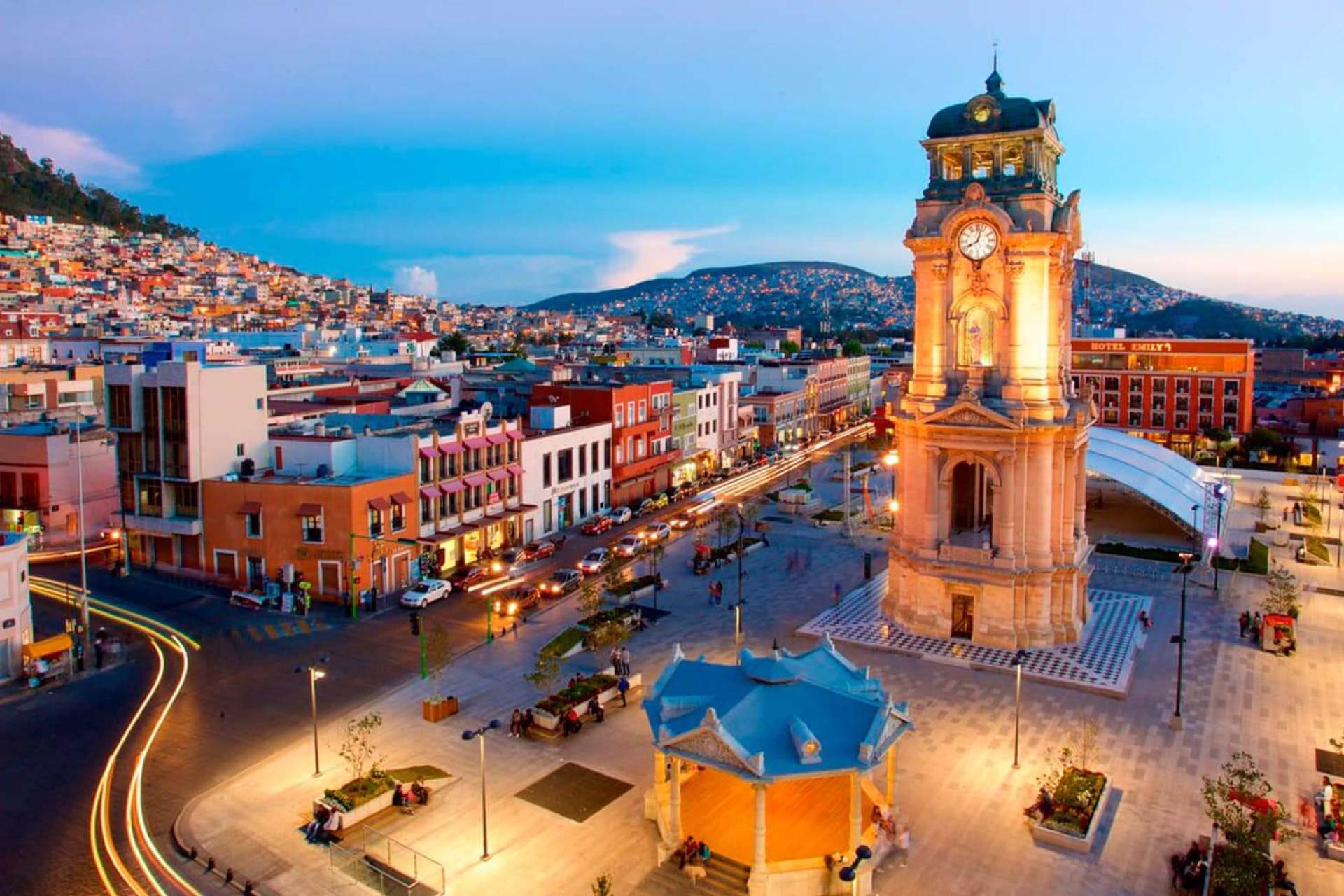
US Production House Boosts Mexican Film in Hidalgo
In an effort to bolster the Mexican film industry, American production company Enfant & Poulet has embarked on an audiovisual project spanning across several municipalities in the state of Hidalgo.… Read More
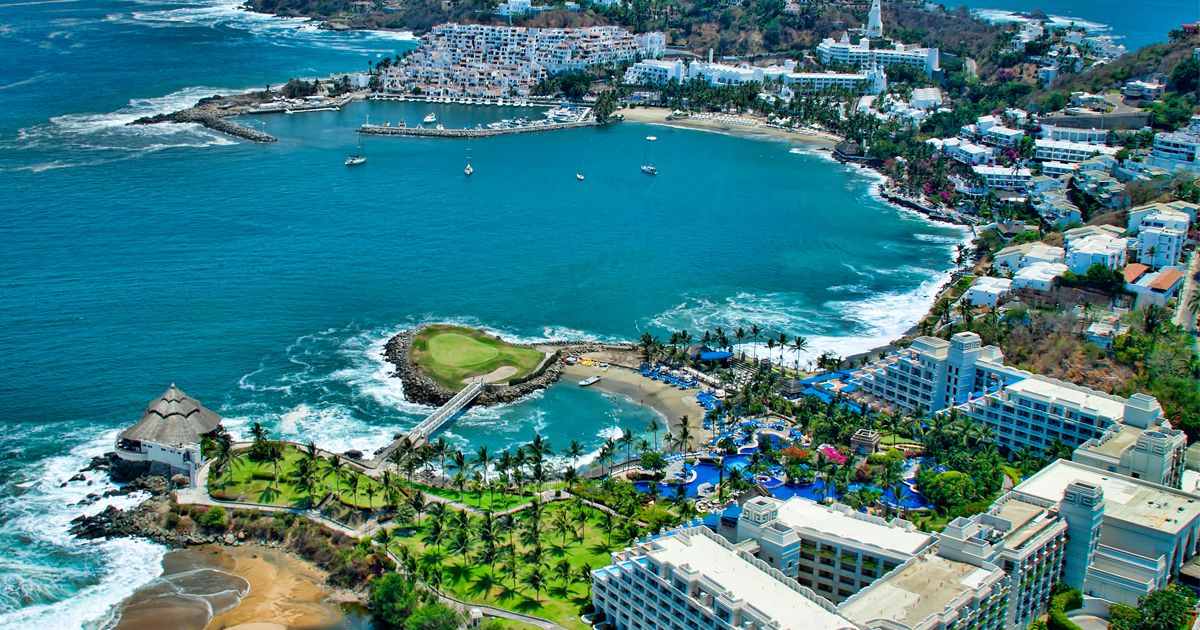
Discover the Magic of Manzanillo’s Agave Route
Manzanillo, a coastal gem in Colima, traditionally known for its sun-soaked beaches, is now diversifying its tourist offerings with the introduction of the Agave Route. This innovative addition allows visitors to immerse themselves in the rich history, traditions, and flavors surrounding Mexico’s iconic agave plant.… Read More
Coral Reefs Vanishing: Quintana Roo Beaches at Risk
The erosion of Quintana Roo’s beaches is a looming threat that could intensify from 2030 onwards due to the loss of the Mesoamerican Reef System (SAM) as a result of climate change, experts warn.… Read More
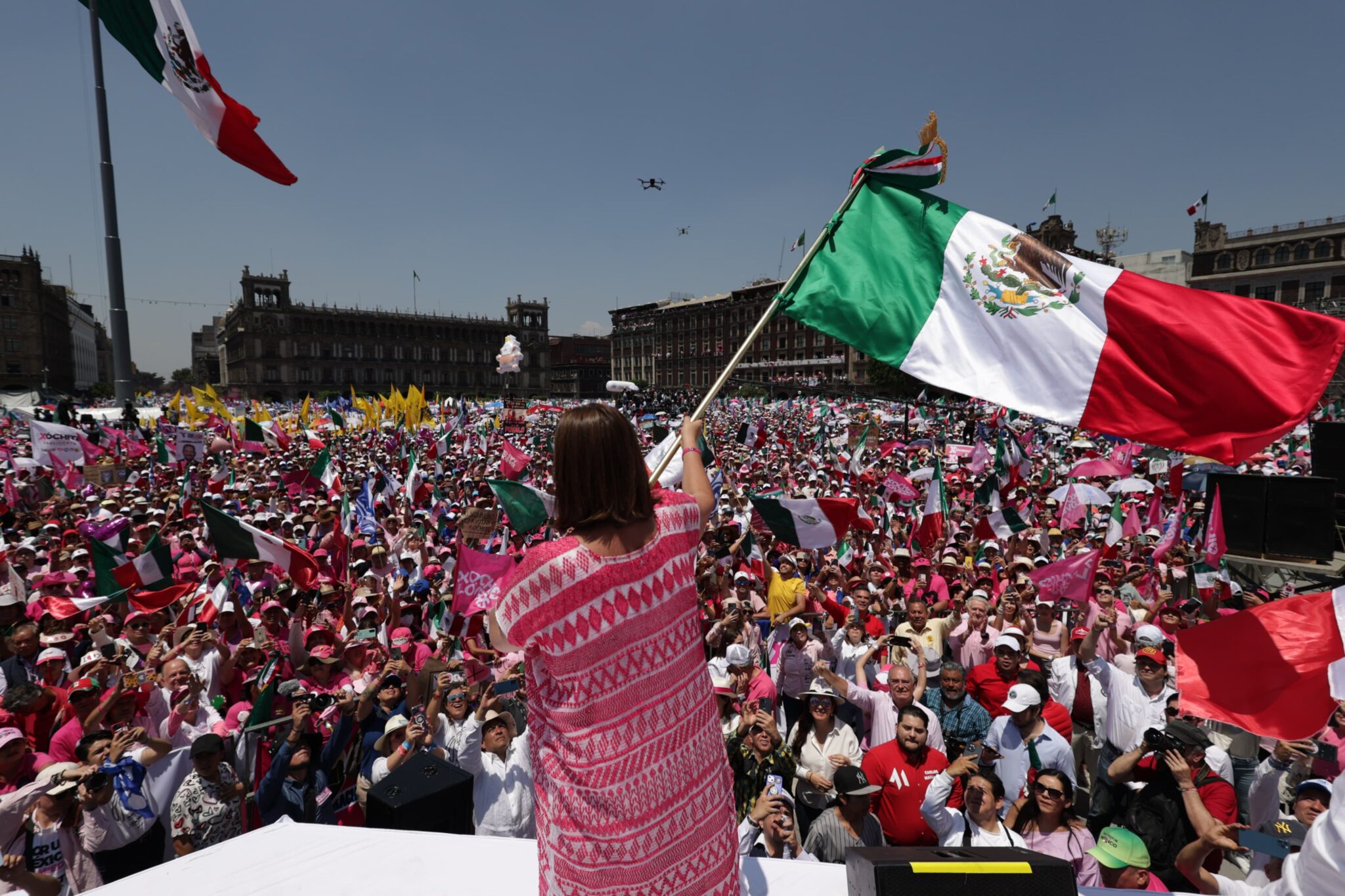
Mexico Prepares for Landmark Election: First Female President in Sight
This Sunday, approximately 98 million Mexicans will cast their votes in a historic election, potentially ushering in the country’s first female president. The election pits Claudia Sheinbaum of the ruling coalition, Let’s Keep Making History, against Xóchitl Gálvez of the opposition alliance, Force and Heart for Mexico, with Jorge Álvarez Máynez of the Citizen Movement also in the race.… Read More
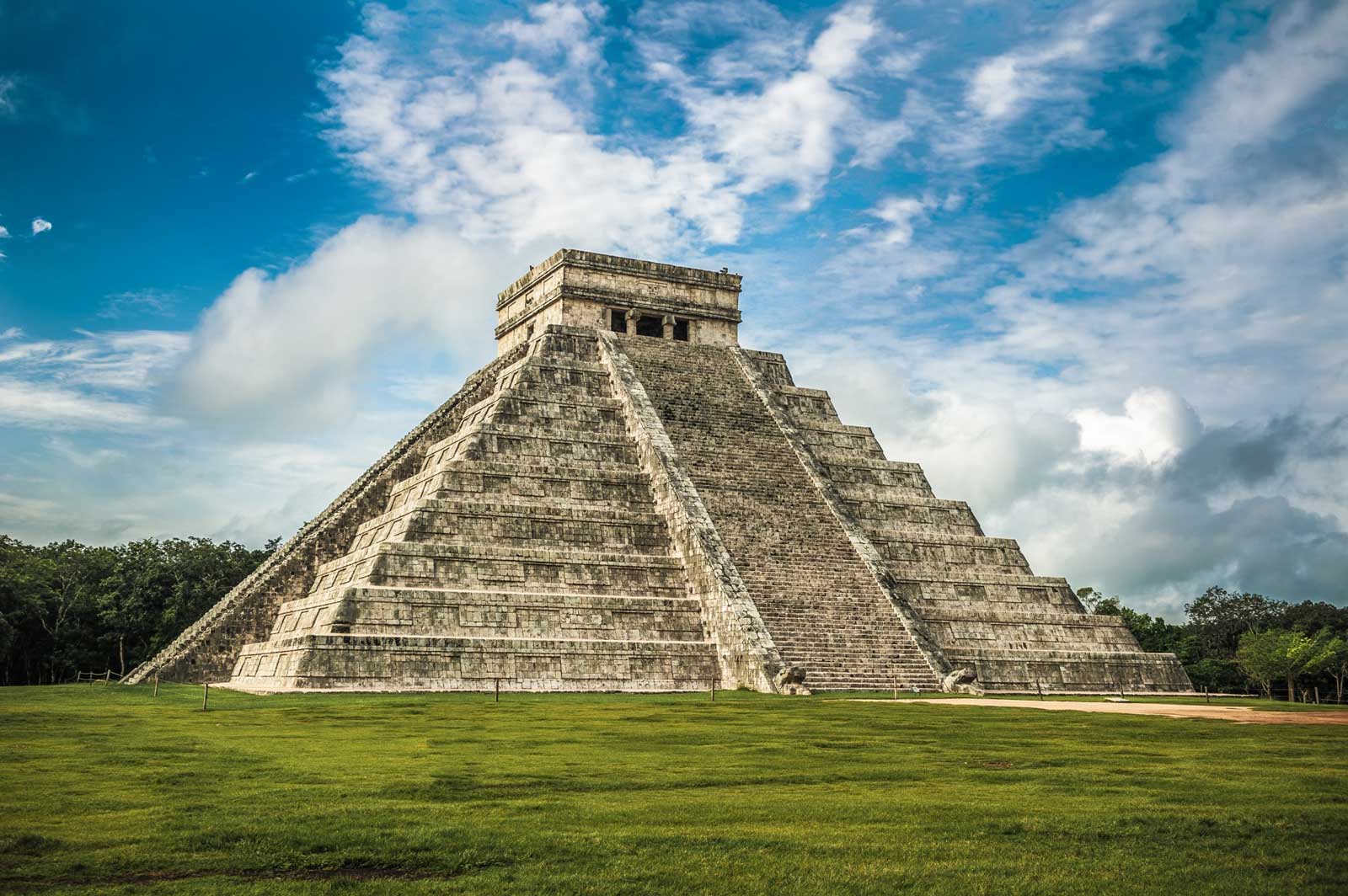
New Air Routes Boost Tourism in Mérida
Mérida is set to enhance its international tourism through the introduction of new air routes. The Director of Economic Development and Tourism of Mérida, José Luis Martínez Semerena, announced partnerships with airlines such as Viva Aerobus to establish direct flights between Mérida and Bogotá, with a layover in Cancún.… Read More
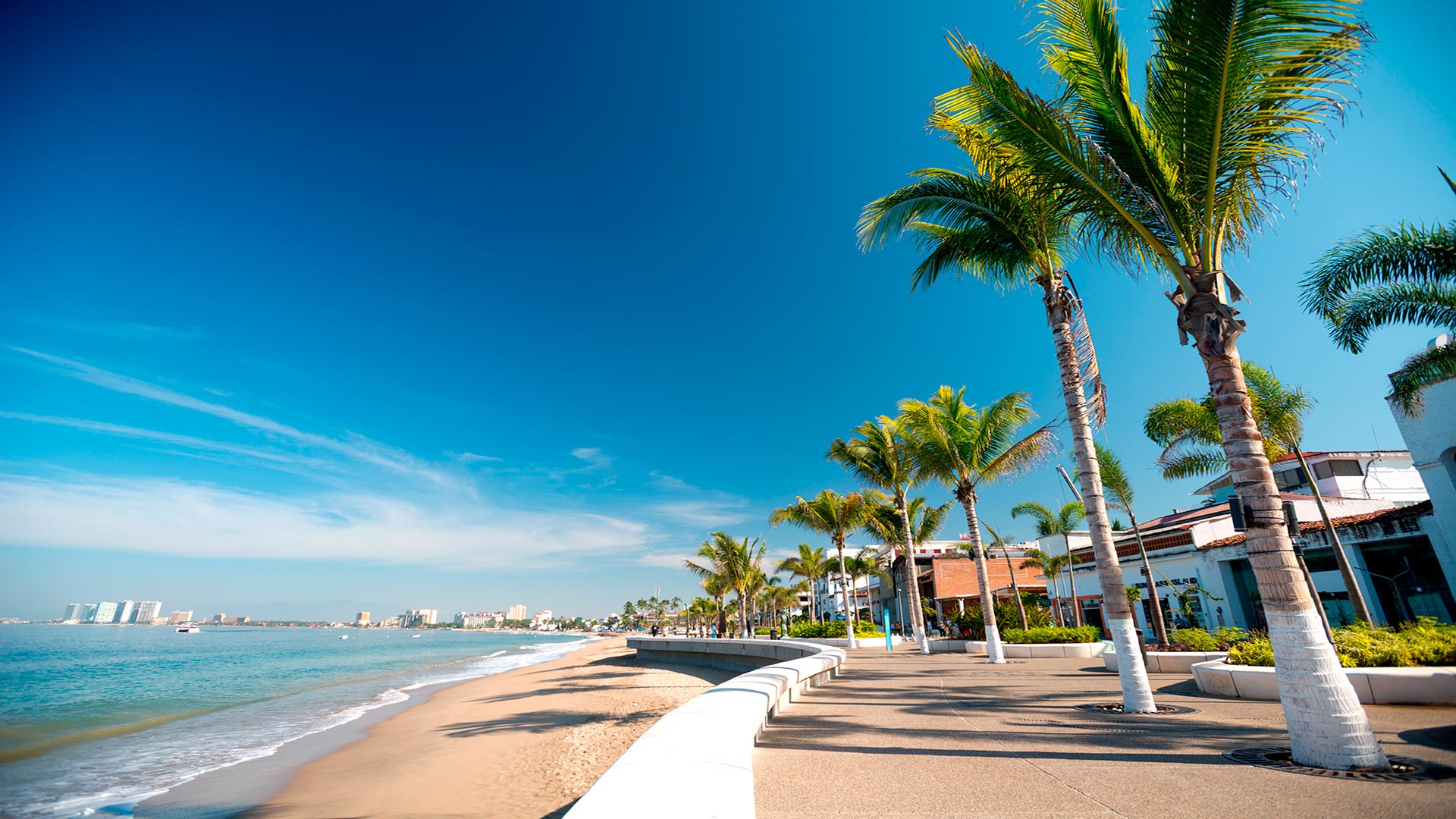
Puerto Vallarta Shines Among World’s Best Free Attractions
Puerto Vallarta, a popular Mexican tourist destination, has been recognized as one of the top 20 places in the world for its outstanding free attractions. The ranking, conducted by NeoMam Studios on behalf of CashNetUSA, places Puerto Vallarta in the 15th spot globally, highlighting its appeal to budget-conscious travelers.… Read More
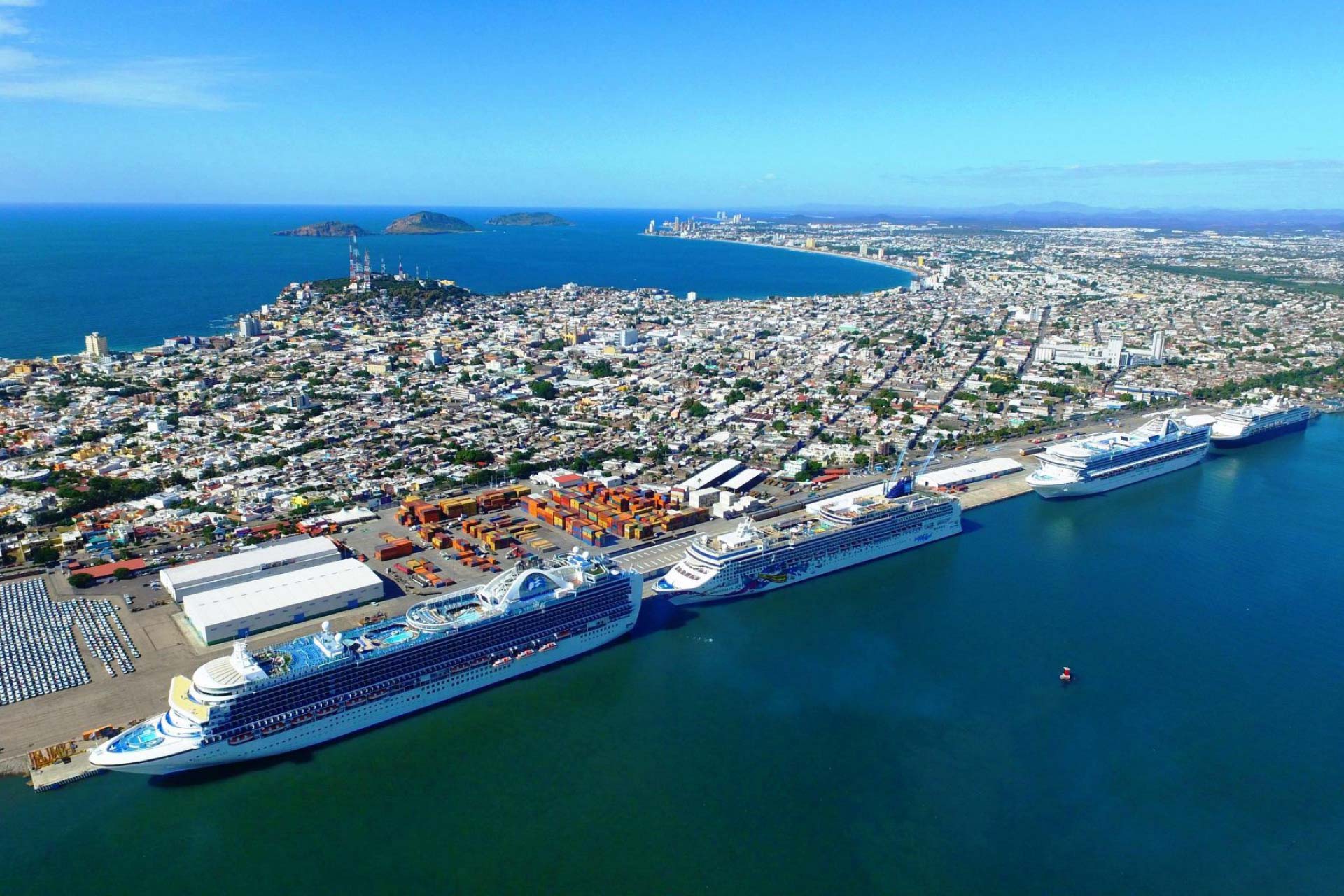
Mazatlán Welcomes Over 35,000 Cruise Ship Visitors in May
Mazatlán has concluded the month of May with a remarkable influx of over 35,000 cruise ship visitors, according to the Sinaloa Secretary of Tourism. This significant increase in tourism was marked by the arrival of the Carnival Panorama cruise ship on Wednesday.… Read More
Mexico Attracts $469.2 Million in FDI for Tourism
Mexico sees significant growth in Foreign Direct Investment (FDI) in the tourism sector, attracting $469.2 million in the first quarter of 2024, a notable increase from $378.3 million in the same period of 2019, according to Tourism Secretary Miguel Torruco Marqués.… Read More
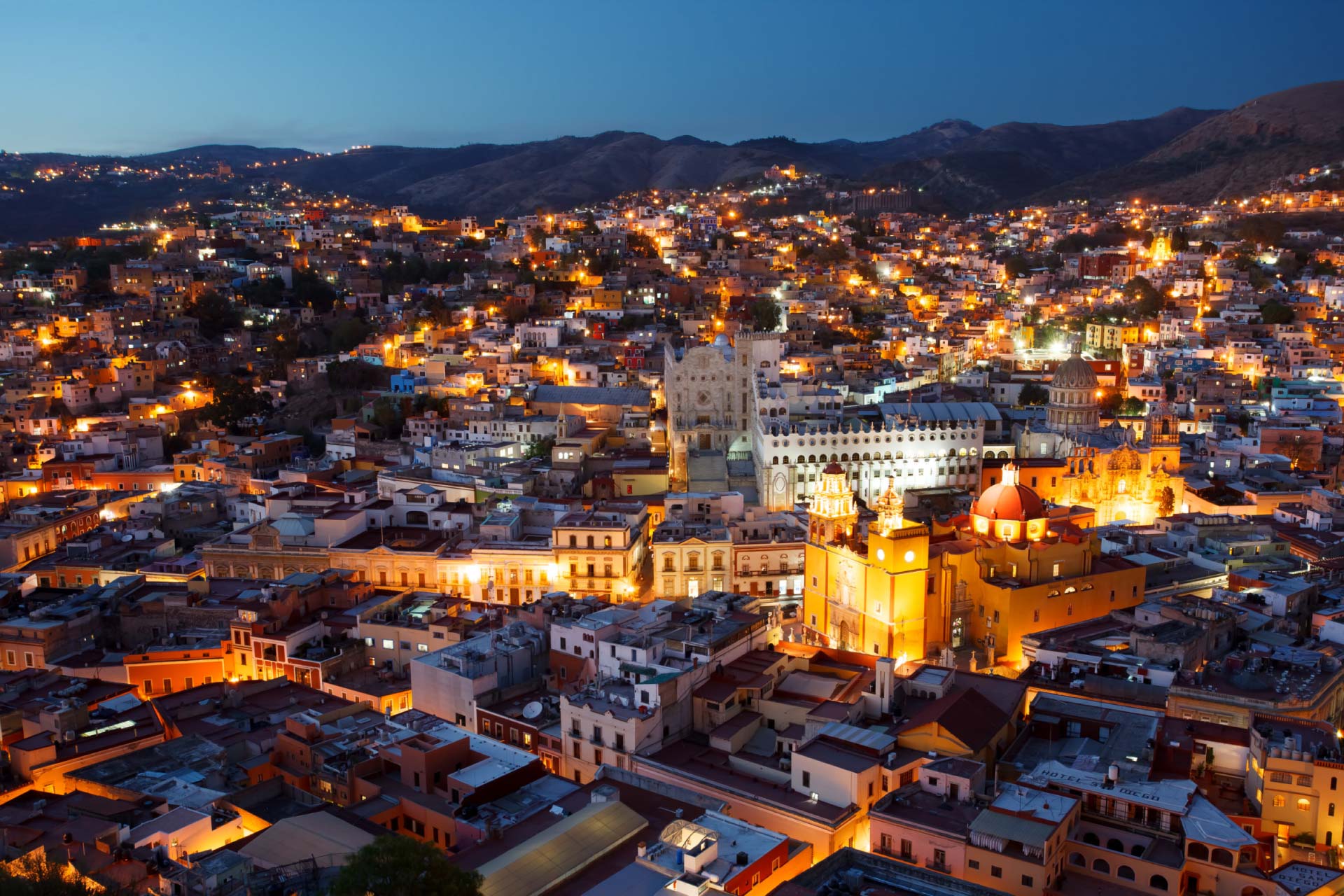
Discover the Enchanting Marfil in Guanajuato
Marfil, a quaint and often overlooked area in Guanajuato, boasts a unique charm that harks back to picturesque Italian villages. This hidden gem, known as the Antiguo Camino a Marfil, is a magical spot filled with history, nature, and allure.… Read More

Culiacán Aims to Boost Meeting and Culinary Tourism
The State Tourism Department is focusing on making Culiacán a leading destination for meeting and culinary tourism, according to Ricardo Velarde Cárdenas, the acting head of Tourism in Sinaloa.… Read More
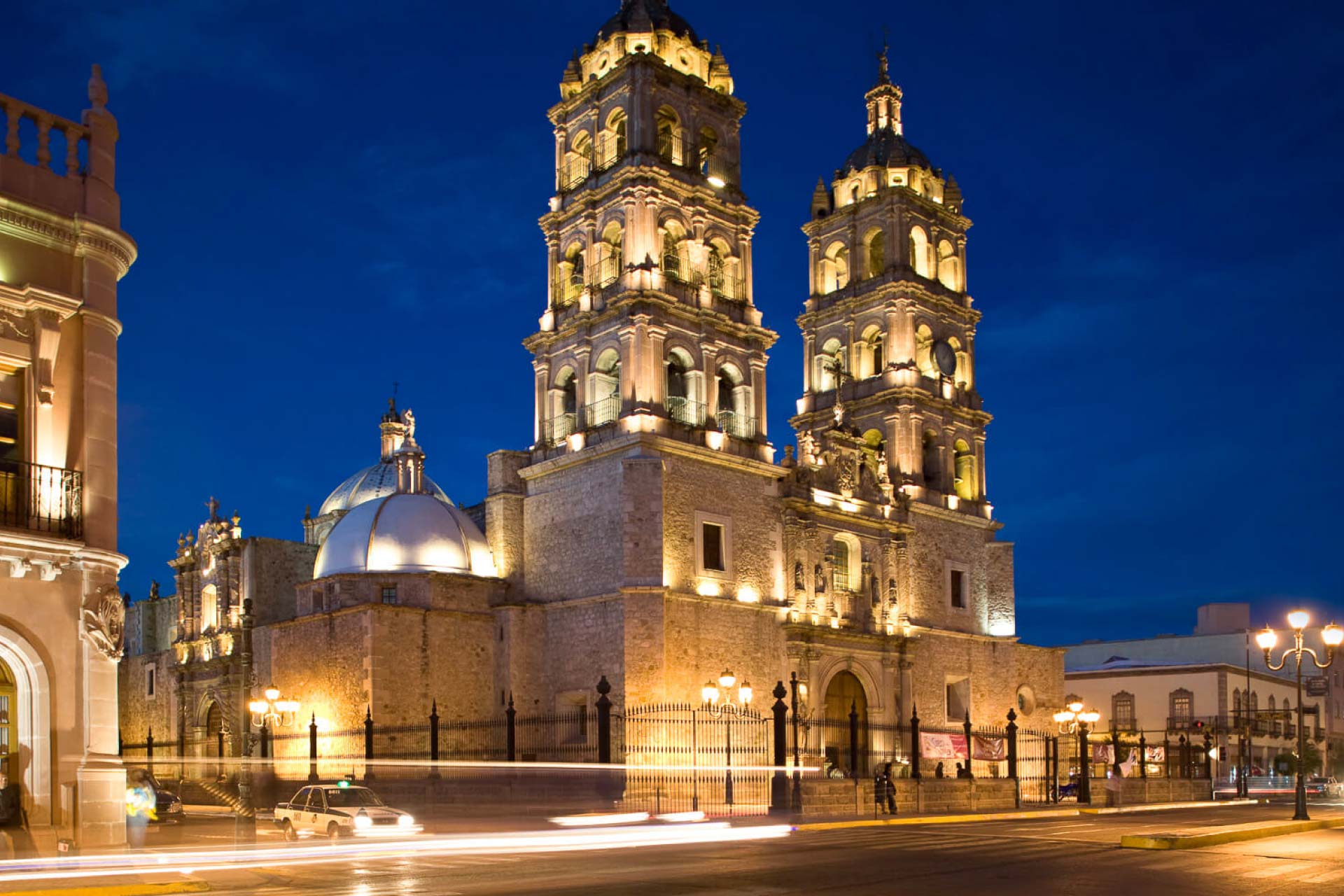
National Durango Fair 2024 Set to Attract Over a Million Visitors
Durango’s National Fair 2024, named “Francisco Villa,” is expected to attract more than a million attendees, with a significant portion being tourists visiting during the vacation season, stated Elisa María Haro Ruiz, Durango’s Secretary of Tourism. The event aims to boost tourism and economic activity in the region.… Read More
Tourist attractions in México

- Traditions in Mexico
It is practically impossible to make a meticulous, and above all, accurate selection of the places to visit in Mexico. Each place that our country houses is unique and beautiful in its own way. Mexico, with its nearly 2 million km², has a large number of scenarios to offer, as well as endless activities to do. Do not lose your way and enter the places to visit in Mexico. In Mexico, apart from the beaches and its famous archaeological sites, there are many other really interesting sites and activities that you should know. In the surroundings of the main cities you will find places full of culture and tradition, where you can spend relaxing, interesting and fun vacations. On your trip through Mexico you cannot stop obtaining souvenirs, the crafts that are made here are of the highest quality and recognized worldwide. A shopping tour cannot be missed.… Read More

- Archaeological Sites
The Archaeological Zones are the cultural past of every Mexican. You will be amazed at the ambient, nature and the environment that surrounds them. Climbing to the top or being around it will take us back in time to admire every detail. México is a country of culture and traditions, many of which we have inherited from the pre-Hispanic inhabitants of this vast territory, although it is true that there were more settlements in the central and southern part of the country, it is also possible to find some archaeological remains in the north. … Read More

- Magical Towns
A Magical Town is a place with symbols and legends, towns with history that in many cases have been the scene of transcendent events for our country, they are places that show the national identity in each of its corners, with a magic that emanates from its attractions ; visiting them is an opportunity to discover the charm of Mexico. The Magical Towns Program contributes to revalue a set of populations in the country that have always been in the collective imagination of the nation and that represent fresh and varied alternatives for national and foreign visitors. A town that through time and in the face of modernity, has conserved, valued and defended its historical, cultural and natural heritage; and manifests it in various expressions through its tangible and intangible heritage. A Magical Town is a town that has unique, symbolic attributes, authentic stories, transcendent events, everyday life, which means a great opportunity for tourist use, taking into account the motivations and needs of travelers.… Read More

The Gastronomy of Mexico has a great diversity of typical dishes, which is why it was recognized by UNESCO as Intangible Heritage of Humanity. The basic and representative ingredients of Mexican dishes are: corn, coriander, chili, beans, piloncillo, nopal and tomato. Mexican cuisine is also characterized by its sauces, which serve as an accompaniment to traditional dishes, prepared based on spices.… Read More

- Capital Cities
Folklore, gastronomy, literary culture, art and exhibitions, is what you will find in the capitals of the states of Mexico. To the north, colonial Mexico, Puebla, Guadalajara, Guanajuato, the Sonoran desert and the California peninsula. To the east Veracruz and the gulf. To the west Acapulco, Oaxaca and Tuxtla Gutiérrez. And to the south the Riviera Maya and the pyramids of Chichén-Itzá, Tulúm and Cobá in Yucatán, Palenque in Chiapas, the cenotes, and the Central American jungles.… Read More

On the Beaches of Mexico you can immerse yourself in the intense blue ocean of the Pacific bays, sunbathe on the shore of the warm and transparent waves of the Caribbean Sea in Quintana Roo or even rest on the beautiful coasts of the Gulf of Mexico. Mexican beaches hide wonderful secrets for the traveler. By visiting them, in addition to enjoying the excellent climate and water activities, you can discover splendid archaeological sites and interesting colonial cities without traveling long distances.… Read More

- Ecotourism and Adventure
Mexico is one of the best countries for Ecotourism as it has a great variety of flora and fauna, as well as a large number of refuges for extraordinary species. You can enjoy recreational activities of appreciation and knowledge of nature through contact with it, such as: stargazing, observation of natural attractions, wildlife and bird watching. Throughout México there are more than 176 protected natural areas, 5 of them considered by UNESCO as Natural Heritage of Humanity. Just for this and much more, we believe that Mexico is a Paradise for Ecotourism.… Read More

States Of Mexico
Mexico has an incredible diversity of landscapes, where the beauty of its beaches, internationally recognized, stands out. In its vast territory of coasts, there are beaches of unparalleled beauty, and colorful landscapes. A large network of first-class hotels and tourist services is available to visitors to these beaches. Mexico is also mystical places, dotted with archaeological testimonies inherited from its original inhabitants. Monuments made by the Mayas, Aztecs and Toltecs are located in magical landscapes, like lighthouses in an ocean of natural beauty. They offer visitors buildings that tell their history, and museums that collect their cultural heritage. And that keep alive ancestral traditions, in ceremonies and festivals, where you can enjoy cultural activities and entertainment.… Read More

Leave a Reply Cancel reply
Your email address will not be published. Required fields are marked *
- States of Mexico
- Animal Rescue in Mexico
Official websites use .gov A .gov website belongs to an official government organization in the United States.
Secure .gov websites use HTTPS A lock ( A locked padlock ) or https:// means you’ve safely connected to the .gov website. Share sensitive information only on official, secure websites.
- Search ITA Search
- Market Overview
- Market Challenges
- Market Opportunities
- Market Entry Strategy
- Leading Sectors for U.S. Exports & Investments Overview
- Advanced Manufacturing
- Agribusiness
- Agriculture
- Automotive Industry
- Construction
- Consumer Goods
- Education and Training
- Environmental Technologies
- Financial Technologies (Fintech) Industry
- Franchising
- Healthcare Products & Services
- Internet and Digital Economy
- IT Equipment and Services
- Mining and Minerals
- Oil and Gas
- Packaging Machinery Industry
- Plastics and Resins
- Power Sector: Electricity Infrastructure and Smart Grid
- Renewable Energy
- Safety and Security
- Transportation Infrastructure Equipment and Services
- Travel and Tourism
- Trade Barriers
- Import Tariffs
- Import Requirements and Documentation
- Labeling/Marking Requirements
- U.S. Export Controls
- Temporary Entry
- Prohibited & Restricted Imports
- Customs Regulations
- Trade Standards
- Trade Agreements
- Licensing Requirements for Professional Services
- Distribution and Sales Channels
- Selling Factors and Techniques
- Trade Financing
- Protecting Intellectual Property
- Selling to the Public Sector
- Mexico- Business Travel and Etiquette
- Investment Climate Statement
With Mexico’s proximity to and familiarity with the United States, it is no surprise that travel and tourism represents a best prospect sector for U.S. destinations seeking Mexican travelers. After a difficult 2020 and 2021 for the global travel and tourism industry, Mexico experienced a significant recovery in travel numbers in 2022. These figures have been boosted by improving economic conditions and the reopening of U.S. travel and tourism services, in addition to the implementation of marketing campaigns to attract Mexican travelers.
The United States is the primary destination for Mexican travelers. In 2022, 12.5 million Mexicans traveled to the United States, representing 24 percent of total foreign arrivals. Mexico the second-largest source of international visitors. Even though 2022 saw a significant recovery in Mexican tourism to the United States, it was still 31 percent below 2019 record levels. According to the U.S. Department of Commerce’s National Travel and Tourism Office (NTTO), spending by Mexican travelers in 2022 totaled USD 19.2 billion. The top destinations for Mexican travelers are Texas, California, Florida, Nevada, and New York, followed by New Mexico, Colorado, Illinois, and Georgia.
Table: Arrivals of Mexican Travelers to the United States (Figures in Millions of Travelers)
Source: U.S. Department of Commerce National Travel and Tourism Office
Leading Sub-Sectors
It is important to differentiate between land and air travelers to the United States. Mexican land tourists typically travel to the southwestern states for shorter visits for family or shopping purposes. On average, Mexican air travelers tend to stay longer and purchase packages that include transportation, lodging, shopping, and recreational activities. Business travel, educational travel, and meeting/conference/incentive/exhibition travel (MICE) are additional segments worthy of attention.
Opportunities
Mexicans are drawn to the United States because of the diversity in destinations, infrastructure, and excellent travel and tourism services. Mexicans enjoy destinations that offer shopping, gaming, entertainment, amusement parks, and a cosmopolitan environment. Natural parks and other outdoor destinations are typically not as popular among Mexican travelers, with skiing being the notable exception. In winter months, Mexican tourists flock to resorts in Colorado, New Mexico, and Utah to ski.
Wholesale operators continue to be an important distribution channel in the Mexican travel and tourism market. Wholesalers sell packages to travel agents who provide services to consumers. Mexican travelers prefer to purchase vacation packages through travel agencies, though purchasing airfare and hotel packages online has become much more common in recent years. United States wholesalers and tour operators are key players in the Mexican market, in part because they can negotiate directly with U.S. travel and tourism service companies and therefore offer competitive prices and packages. To save money, wholesalers in Mexico are now buying products and services from tour operators in the United States, who deal directly with local tourism service providers that develop travel packages. The younger Mexican population is much more comfortable buying travel packages over the Internet. The biggest online travel agencies in Mexico now offer hotel rooms, air tickets, and travel packages through their own websites. Travelers often have the option to pay for their travel to the United States by debit or credit card in fixed installments with no interest.
Social networking is increasingly important for the promotion of travel and tourism services. Several U.S. destinations and providers of travel and tourism services represented in Mexico have launched promotional campaigns through social networks including Facebook, Twitter, YouTube, and Instagram. Most of these promotional campaigns are in Spanish and include interaction with the end-consumer and travel agents.
To be successful in the market, it is crucial to establish and maintain personal relationships with travel and tourism companies in Mexico. United States travel and tourism firms are advised to travel to Mexico and develop a comprehensive follow-up strategy in order to gain sufficient exposure in the Mexican market. As a result of the COVID-19 pandemic, all U.S. destinations and service providers have invested in aggressive post COVID-19 marketing and promotional campaigns to recover market volume. These activities should include deals and promotions by travel services and destinations for local wholesalers. United States destinations and services providers are taking advantage of IT tools and virtual communication platforms to increase education on future attractions and services among potential Mexican tourists. Social media has represented an important way to continue promoting U.S. destinations and services to maintain the interest of the Mexican traveler and to entice them to visit the United States.
Mexican buyers have identified specific activities and segments of the market with good business potential. Entertainment options, such as attending major sports events or concerts in the United States, have become very popular among Mexican travelers. Promoting destinations and tourism services to the Mexican LGBTQI+ community also represents a good market opportunity. Multiple studies show that LGBTQI+ individuals are often considered strongly entrepreneurial, are usually owners of their businesses, and dedicate a significant amount of financial resources to leisure activities such as tourism. Culinary activities are also an important market niche that gets the attention of the Mexican visitor to the United States.
According to the U.S. Department of Commerce’s Office of Travel and Tourism Industries, 33.5 million U.S. citizens traveled to Mexico in 2022. This travel may also present business opportunities to U.S. firms offering packages and travel services geared towards U.S. travelers to Mexico.
- International Pow Wow (IPW), May 3-7, 2024. Los Angeles, CA
- Brand USA Mission to Mexico, January 2024. TBD
For more information on the travel and tourism services sector in Mexico, please contact:
Juan Carlos Ruíz
Commercial Specialist
U.S. Commercial Service —Mexico City
Tel.: +52 (55) 5080-2000 ext. 5223

What are you looking for?
56+ mexico travel & tourism statistics [fresh for 2024].
Teeming with incredible food, ancient temples, and stunning beaches, Mexico has long been one of the most prominent travel destinations in the world.
It’s home to many different activities suited to all travelers, from surfing in Puerto Escondido to relaxing in the sun at an all-inclusive in Cancun .
Did you know that the country welcomed 45 million overseas tourist arrivals in 2019?
From luxurious overwater bungalows to affordable backpackers hostels, the country is suitable for all sorts of travel budgets.
If you want to understand more about travel and tourism in Mexico, you’ve come to the right place.
Today, we’ve gathered and summarised the latest statistics about Mexico’s tourism.
Let’s dive right in!
Sources : We have included every source used under each stats, or head over to the bottom of this post for the full list of articles and references.
Travellerspoint
How many tourists visit Mexico annually?
There were 45 million international tourist arrivals to Mexico in 2019.
How big is the tourism industry in Mexico?
Tourism contributes nearly 1.8 trillion pesos to Mexico’s economy, which is around 7% of the total GDP.
How much does tourism contribute to Mexico?
International tourism receipts in Mexico were at $25.85 billion in 2019.
Where does Mexico rank in tourism?
According to the UNWTO World Tourism Barometer in 2023, Mexico is the world’s second most visited country.
Mexico Travel & Tourism Main Statistics
- There were a total of 31.9 million international tourist arrivals in Mexico in 2021, a rise from 24.3 million in 2020.
- In 2019, a total of 17.6 international visitors passed through Mexico City International Airport.
- Mexico is the most popular international travel destination for American travellers in 2019, with 39.3 million visitors from the US.
- In 2021, domestic tourism expenditure in Mexico rose by 9% to 3 trillion Mexican pesos.
- The tourism sector in Mexico contributed almost 1.8 trillion pesos to the country's GDP in 2021.
- The average international tourist in Mexico spends $385 during their trip.
- Chichén Itzá was the most visited archeological site in Mexico in 2021.
- There is a total of 24.7 thousand hotels and similar establishments in Mexico in 2020, compared to the 16.9 thousand in 2010.
- Mexico is the sixth most visited country by digital nomads on Nomad List, visited by 4% of nomads.
Mexico Inbound Tourism Travel Statistics
How many tourists visit Mexico each year?
1. There were a total of 31.9 million international tourist arrivals in Mexico in 2021, a rise from 24.3 million in 2020.
However, this is still well below the pre-pandemic levels of 45 million international tourist arrivals in 2019.

2. Between January and November 2022, 34.7 million international tourists arrived in Mexico.
[Embassy of Mexico]
3. In 2021, Mexico recorded more international tourist arrivals than even the United States, which had just 22.1 million arrivals.
A lot of this was because Mexico maintained loose travel restrictions during the pandemic, allowing some 24 million international tourists to visit in 2020 .
4. There were 3.36 million overseas tourists in the first six months of 2022 in Mexico, higher than the recorded 3.12 million of the previous year.
[Travel Pulse]
5. According to the UNWTO World Tourism Barometer in 2023, Mexico is the second most visited country in the world after France.
[Travelness]
Mexico received 31.9 million annual visitors, surpassed only by France with 48.4 million visitors .
6. In 2019, a total of 17.6 international visitors passed through Mexico City International Airport.
Mexico City International Airport is the country’s top airport for inbound travel.
As the capital city of Mexico, Mexico City offers many activities and things to do !
7. However, in 2022, Cancun International Airport welcomed the most international visitors (8.56 million).
Mexico City International Airport saw 3.8 million visitors and Los Cabos Airport received 1.94 million visitors.
Meanwhile, Puerto Vallarta airport had 1.47 million arrivals.

8. Mexico is the most popular international travel destination for American travellers in 2019, with 39.3 million visitors from the US.
In 2019, there were a total of 39.3 million tourists from the USA to Mexico.
9. Tourists arriving by air also increased in June 2022 by 28.5% to 1.88 million arrivals
This is compared to 1.46 million air arrivals in June 2021.
10. However, the number of tourists arriving by land actually dropped by 16.6% in June to 1.07 million travellers.
11. the largest source market for international tourists in mexico is usa, with 11.7 million air arrivals in 2022., 12. the us is followed by canada with 1.5 million arrivals in mexico in 2022..
There were approximately 1.5 million Canadian arrivals in Mexico in 2022.
13. After that are Colombia (787,000), the United Kingdom (523,000), and Spain with 335,000.
The fourth largest source market for international tourists in Mexico is the UK, with 523 thousand arrivals recorded in 2022.

14. Other world nationalities comprised 3.6 million of the total overseas arrivals in Mexico in 2022.
Domestic tourism in mexico statistics.
How many domestic tourists are there in Mexico?
15. In 2019, there were over 62 million domestic tourists staying at hotel establishments throughout the country.
But in 2020, the number of domestic tourists at Mexican hotels in Mexico fell due to the pandemic.
16. In 2021, domestic tourism expenditure in Mexico rose by 9% to 3 trillion Mexican pesos.
17. around 3 in 5 mexicans who go on a vacation state that they usually go to a domestic destination for holiday., 18. the most popular domestic holiday destination in mexico in 2022 was guadalajara. 90% of mexicans stated that it’s their preferred destination for a domestic holiday..
This was chosen as the preferred domestic holiday destination by more than 90% of Mexicans, thanks to all the different and unique things to do in Guadalajara .
19. For domestic trips, more than 50% of respondents say that restaurant offers are the most attractive aspect.
20. meanwhile, food at a local destination is the most appealing thing from a domestic trip for 44% of travellers., 21. the favorite type of vacation for mexicans would include visits to tourist attractions, as stated by 60% of mexicans in a 2022 survey., 22. in 2019, 85% of total travel and tourism spending in mexico was from domestic tourists..
The percentage remained consistent in 2021, with domestic spending contributing 86% of the total travel spending in Mexico.

Key economic figures in Mexican travel & tourism
23. the tourism sector in mexico contributed almost 1.8 trillion pesos to the country's gdp in 2021., 24. this figure is roughly 7% of the total mexican gdp., 25. in 2020, expenditures by international inbound visitors to mexico amounted to $11.45 billion..
[Macro Trends]
This figures is a 55.7% decline from 2019, when international tourism receipts were at $25.85 billion.
26. In 2020, international tourism expenditure made up 2.64% of exports in Mexico, a sharp decline from the 5.25% share of exports in 2019.
27. the average international tourist in mexico spends $385 during their trip..
In contrast, Mexican tourists spend an average of $160 per person when travelling overseas.
28. The accommodation industry alone generated 600 billion Mexican pesos in 2021.
Accommodation was the highest contributor of travel-related GDP in Mexico.
29. In comparison, restaurants, bars and nightclubs contributed 255 billion Mexican pesos in GDP.
30. the amount of tourism foreign direct investment (fdi) in mexico was $2.2 billion in 2021, the highest since 2010 and around 70% higher than in 2019 and 2020., 31. there were 118 thousand tourism establishments in mexico in 2019, 90% more than the figure in 2010..
Tourism establishments include those in the accommodation, food service, and reservation industries.
Mexican Travel & Tourism Industry Employment
How does travel and tourism contribute to Mexico’s job industry?
32. In 2021, there were 6.03 million jobs related to travel and tourism in Mexico, which is the second highest number in a Latin American country after Brazil.
Compared to Mexico, in Peru there were just 0.96 million travel and tourism jobs in 2021.
33. Excluding informal employment, the sector provides 2.3 million fulltime jobs (5.9% of fulltime employment in Mexico).
34. tourism in mexico also represents 79.9% of the country’s exports in services., mexican travel destination & activity statistics.
What are the top travel destinations in Mexico?
35. In 2021, the country with the most UNESCO World Heritage properties in Latin America was Mexico, with a total of 35.
It’s followed by Brazil’s 23 sites and 13 World Heritage sites in Peru .
36. Chichén Itzá was the most visited archeological site in Mexico in 2021.
37. the second most popular site, teotihuacán, had more than 900 thousand total visitors in 2021., 38. the mexican port with the most cruise passenger traffic in 2021 is cozumel, with 44% of all cruise passengers in mexico traveling there., 39. the second most popular port among cruise travelers was majahual in quintana roo., 40. as of november 2021, oaxaca de juarez is the cheapest city to travel to in north america, costing only $30.60 per day..
In fact, Mexico is the perfect destination for backpackers as the five cheapest North American cities to travel to are all based in Mexico. Oaxaca de Juarez takes the lead at a daily cost of just $30.60 .
Hotel Industry Statistics in Mexico
How many hotels are there in Mexico?
41. There is a total of 24.7 thousand hotels and similar establishments in Mexico in 2020, compared to the 16.9 thousand in 2010.
In 2020, there were 24.7 thousand hotels and similar establishments in Mexico.
42. In 2021, Mexican hotels had an average room occupancy of 41.4%.
43. beach hotels in mexico tend to have a higher room occupancy rate than city hotels. in 2021, beach hotels recorded 49% occupancy compared to just 35.5% of hotels in city areas..
Hotels in coastal areas like Isla Mujeres tend to attract more guests than city-based hotels.
44. The Mexican tourist destination with the highest hotel occupancy is Los Cabos, with an impressive 60% hotel occupancy rate.
They’re followed by Mazatlán in Sinaloa, which is a beautiful beachside getaway with lots of things to do !
45. The Mexican region with the most hotels in August 2022 was Veracruz, with 1,784 establishments.
46. it was followed by jalisco with 1,400 hotels, whereas mexico city had 840 hotel establishments in august 2022., 47. in 2021, the leading hotel company in mexico was amresorts. they recorded more than 28 billion mexican pesos of net revenue., 48. the riviera maya and mexico city each recorded more than 12 million occupied rooms in 2019..
The top five tourist destinations for overnight visitors in Mexico is rounded up by Cancún, Los Cabos, and Guadalajara.
Known for its stunning white sand beaches and nightlife, you won’t find a short of things to do in Cancun .
49. The best rated resorts in Mexico in 2022 is Conrad Tulum Riviera Maya in Tulum, followed by One&Only Palmilla.
Tulum itself has plenty of interesting things to do .

Other travel accommodations in Mexico
How many Airbnbs are there in Mexico?
50. From November 2019 to March 2020, the share of domestic Airbnb guests were at a record-high, varying between 63% to 70%.
The share of domestic compared to international guests in Airbnbs across Mexico was between 63% to 70% in the period of November 2019 to March 2020.
51. In 2020, RV sales in Mexico have increased by over 31% in the past year.
[RV Business]
Travelling in RVs is a rising trend in Mexico, shown by the fact that sales of RVs in 2020 had grown by more than 31% .
Travel behaviour and preferences in Mexico
How and why do people visit Mexico?
52. Mexico is the sixth most visited country by digital nomads on Nomad List, visited by 4% of nomads.
[Nomad List]
Along with Mexico, Germany and the UK is also each visited by 4% of all digital nomads .

53. Mexico City also happens to be the 13th most liked city for female digital nomads.
Although Mexico City received a 4.09 rating by female travellers who work remotely, the city isn’t included on the top 15 most cities liked by male digital nomads.

54. In 2019, business travel in Mexico City cost almost $220 daily for international guests, with hotels making up for over two-thirds of that budget.
In Mexico City in 2019, the daily cost of business travel amounts to nearly $220 .
55. In 2021, leisure tourism represented 95% of the total tourism expenditures in the North American country that year.
56. more than half of mexicans go on a holiday with their family..
In 2022, over 50% of Mexicans travel with their family.

57. In comparison, only 4% of respondents in a Mexican tourism survey go on a solo trip.
According to a 2022 survey, solo trips are not popular among Mexicans, with only 4% of them going on a holiday only .
From relaxing beach life to the party scene in Cabo San Lucas , there are many facets of Mexico that one could explore.
That’s all for our Mexico travel statistics.
We hope the information could help you learn more about tourism in this beautiful country!
Let us know if we missed any important points…
In the meantime, check out these other statistics:
- Peru Travel & Tourism Statistics
- Las Vegas Travel & Tourism Statistics
- California Travel & Tourism Statistics
- Embassy of Mexico
- Travel Pulse
- Macro Trends
- RV Business

Leave a comment
Let us know what you think.

5 million people can't be wrong
Winter is here! Check out the winter wonderlands at these 5 amazing winter destinations in Montana
- Travel Destinations
How Is Tourism Important To The Mexican Economy
Published: December 12, 2023
Modified: December 28, 2023
by Georgette Bell
- Plan Your Trip
- Travel Guide
Introduction
Mexico, with its rich history, vibrant culture, and stunning landscapes, has become one of the most popular tourist destinations in the world. From ancient Mayan ruins to vibrant colonial cities, pristine beaches to bustling markets, Mexico offers a diverse range of attractions that appeal to travelers from all over the globe.
But beyond its allure as a tourist destination, tourism plays a vital role in the Mexican economy. As one of the largest contributors to the country’s GDP, tourism has a significant impact on various sectors, including employment, infrastructure development, and cultural preservation.
This article delves into the importance of tourism to the Mexican economy, exploring the economic benefits, employment opportunities, foreign exchange earnings, and overall contribution to the Gross Domestic Product (GDP). It also examines the challenges and risks associated with the tourism sector and the government’s initiatives to promote and sustain this vital industry.
So, let’s embark on a journey to discover how tourism drives the Mexican economy and why it is an integral part of Mexico’s growth and development.
Historical Overview of the Mexican Economy
The Mexican economy has a rich and complex history, shaped by various factors such as colonization, industrialization, and globalization. Prior to the arrival of Spanish conquistadors in the 16th century, Mexico was inhabited by advanced indigenous civilizations, including the Aztecs and Mayans. These societies had well-developed agricultural systems and traded valuable goods such as gold, silver, and jade.
With the arrival of the Spanish, Mexico became a colony and its economy was heavily influenced by the demands of the Spanish Empire. The extraction of resources, particularly silver, became the foundation of the Mexican economy during this period. This economic model continued until Mexico gained independence in the early 19th century.
As an independent nation, Mexico faced significant political instability and economic challenges. However, the late 19th and early 20th centuries saw the emergence of industries such as textiles, mining, and oil production, which laid the groundwork for industrialization and modernization. The implementation of economic reforms and the establishment of key institutions, such as the National Bank of Mexico, further propelled economic growth.
Despite periods of economic turbulence, Mexico experienced steady economic growth during the latter half of the 20th century. The country adopted a policy of import substitution industrialization, aiming to decrease reliance on foreign imports and promote domestic industrial production. This period also saw the expansion of the tourism industry, as Mexico’s natural beauty and cultural heritage attracted increasing numbers of visitors.
In recent decades, Mexico has undergone various economic reforms, including the signing of free trade agreements and opening up markets to foreign investment. These reforms have helped position Mexico as one of the world’s largest exporters, particularly in manufacturing industries such as automobiles, electronics, and aerospace.
Furthermore, the Mexican economy has diversified to include a strong services sector, with tourism playing a significant role in generating revenue and employment opportunities. The government has recognized tourism as a strategic sector for economic development and has implemented initiatives to promote Mexico as a premier tourist destination.
In the next sections, we will delve into the specific details of the Mexican tourism industry and its importance to the overall economy.
Overview of the Mexican Tourism Industry
The Mexican tourism industry has experienced remarkable growth over the years, establishing itself as one of the leading tourist destinations worldwide. With its diverse array of attractions, ranging from ancient archaeological sites to modern beach resorts, Mexico offers something for every type of traveler.
Beaches are undoubtedly one of Mexico’s greatest draws, attracting millions of tourists each year. Destinations like Cancun, Playa del Carmen, and Tulum on the Yucatan Peninsula boast pristine white sands, crystal-clear turquoise waters, and luxurious beachfront resorts. These areas offer activities such as snorkeling, scuba diving, and exploring the world’s second-largest barrier reef, providing an unforgettable tropical paradise experience.
However, Mexico goes beyond just beach resorts. The country is home to numerous UNESCO World Heritage sites, including the ancient cities of Chichen Itza, Teotihuacan, and Palenque. These archaeological wonders showcase the rich history and architectural brilliance of the ancient civilizations that once thrived in Mexico.
In addition to its historical sites, Mexico’s vibrant cities charm visitors with their colorful colonial architecture, lively markets, and delectable cuisine. Cities like Mexico City, Guadalajara, and Oaxaca offer a mix of cultural experiences, showcasing traditional arts, music, and gastronomy.
Nature enthusiasts are also drawn to Mexico’s diverse ecosystems. The country boasts stunning natural wonders, such as Copper Canyon, a network of canyons larger and deeper than the Grand Canyon, and the Monarch Butterfly Biosphere Reserve, where millions of butterflies migrate each year.
Moreover, the Mexican tourism industry caters to various niches, including adventure tourism, eco-tourism, and medical tourism. Activities such as zip-lining through the jungle, exploring cenotes (natural sinkholes), or receiving medical treatments at state-of-the-art facilities are all part of the diverse range of experiences available in Mexico.
Overall, the tourism industry in Mexico has flourished due to the country’s geographical, cultural, and historical offerings. With a steady influx of visitors from around the globe, the Mexican economy has benefited significantly from the revenue generated by tourism. In the following sections, we will explore the economic importance of tourism in Mexico in greater detail.
Importance of Tourism to the Mexican Economy
Tourism plays a crucial role in driving the Mexican economy, contributing significantly to various sectors and generating substantial revenue. The importance of tourism can be seen through its economic benefits, employment opportunities, foreign exchange earnings, and overall contribution to the Gross Domestic Product (GDP).
One of the key economic benefits of tourism in Mexico is the substantial revenue it generates. The money spent by tourists on accommodations, dining, transportation, shopping, and activities directly stimulates local businesses and contributes to the overall economic growth of the country. This infusion of funds into the economy helps support small and medium-sized enterprises, fosters entrepreneurship, and boosts consumer spending.
Furthermore, tourism in Mexico creates extensive employment opportunities. The industry directly employs a significant number of people in sectors such as hospitality, transportation, tour operators, and attractions. Additionally, the ripple effect of tourism extends beyond the direct employees, as it stimulates job creation in related industries such as agriculture, handicrafts, and entertainment. The employment generated by tourism provides income and livelihoods for individuals and their families, contributing to poverty reduction and social well-being.
Foreign exchange earnings from tourism are a significant source of revenue for Mexico. With millions of international visitors spending money in the country, tourism contributes substantially to the balance of payments. The revenue earned from foreign tourists helps stabilize the economy, contributes to the maintenance of a favorable exchange rate, and provides the necessary foreign currency to finance imports and external obligations.
In terms of its contribution to the GDP, tourism has consistently played a vital role. The World Travel and Tourism Council reported that in 2019, the direct contribution of travel and tourism to Mexico’s GDP was 8.7%. This figure takes into account the direct spending by tourists as well as the investment in the tourism sector, such as infrastructure development and marketing campaigns. The total contribution, including indirect and induced impacts, is even more substantial, making tourism a cornerstone of the Mexican economy.
Moreover, tourism stimulates infrastructure development and investment. The growth of the tourism industry necessitates the construction of new hotels, resorts, airports, roads, and other tourism-related infrastructure. These developments not only enhance the visitor experience but also benefit the local population. Improved infrastructure attracts further investment, creates jobs, and drives economic development in the surrounding communities.
Lastly, tourism plays a vital role in cultural preservation and promotion. Mexico’s cultural heritage, including its traditions, festivals, cuisine, and arts and crafts, is an integral part of its appeal to tourists. Through tourism, Mexican cultural traditions are promoted and preserved, and artisans and performers have the opportunity to showcase and sell their crafts and talents. This contributes to the revitalization and continuation of cultural practices, ensuring their perpetuation for future generations.
Overall, the importance of tourism to the Mexican economy cannot be overstated. With its ability to generate revenue, create employment, drive infrastructure development, boost foreign exchange earnings, and preserve cultural heritage, the tourism industry holds immense potential for economic growth and prosperity in Mexico.
Economic Benefits of Tourism in Mexico
The tourism industry in Mexico brings forth significant economic benefits, positively impacting various sectors of the economy. Let’s explore the key economic advantages that tourism provides to the country.
Firstly, one of the major economic benefits of tourism is the infusion of foreign currency into the Mexican economy. International tourists spending money on accommodations, dining, shopping, transportation, and attractions contribute to the country’s foreign exchange earnings. This influx of foreign currency helps to stabilize the economy, strengthen the national currency, and support imports and external financial commitments.
Secondly, the tourism industry in Mexico generates substantial revenue. Tourists, both domestic and international, spend money on a range of goods and services, providing a significant boost to local businesses. Hotels, restaurants, tour operators, souvenir shops, and transportation services all benefit from the spending of tourists. This revenue supports local economies, encourages entrepreneurship, and stimulates further investment in the tourism sector.
Additionally, tourism plays a crucial role in job creation. The industry directly employs a large number of people in various sectors, including hospitality, transportation, entertainment, and attractions. Thousands of individuals find employment opportunities in hotels, restaurants, travel agencies, and tour companies. Moreover, the indirect effects of tourism stimulate job creation in related industries such as agriculture, handicrafts, and retail. These employment opportunities not only provide income for individuals and their families but also contribute to poverty reduction and overall social well-being.
Tourism also brings about a positive impact on other sectors of the economy, such as agriculture and manufacturing. As the demand for goods and services increases with the growth of the tourism industry, local farmers and producers benefit from the increased demand for agricultural products and other supplies. Artisans and craftsmen also thrive as tourists seek to purchase unique local handicrafts and souvenirs. This interconnection between tourism and different sectors of the economy helps to diversify income streams and foster economic resilience.
Moreover, tourism provides a platform for infrastructure development and investment. The growth of the tourism industry often requires the construction of new hotels, resorts, airports, roads, and other tourism-related infrastructure. These developments not only enhance the visitor experience but also benefit the local population. Improved infrastructure attracts further investment, creates jobs, and drives economic development in the surrounding communities. The development of tourism-related infrastructure helps to increase the overall competitiveness of the destination and attract more visitors in the long run.
Lastly, the tourism industry contributes to tax revenues for the Mexican government. The taxes levied on accommodations, restaurants, transportation, and other tourism-related activities generate significant tax income. This revenue plays a vital role in funding public services, infrastructure projects, and social welfare programs, benefiting both the tourism industry and the wider society.
Overall, the economic benefits of tourism in Mexico are substantial. From the generation of foreign exchange earnings to revenue generation, job creation, stimulation of related industries, infrastructure development, and tax revenues, tourism plays a pivotal role in driving economic growth, stability, and prosperity in the country.
Employment Opportunities Created by Tourism
The tourism industry in Mexico serves as a significant source of employment, offering diverse and widespread job opportunities across various sectors. The sector’s ability to generate employment is a crucial aspect of its contribution to the Mexican economy and social well-being.
Directly, tourism provides a wide range of job opportunities in sectors such as hospitality, transportation, and entertainment. Hotels, resorts, and other accommodation establishments employ staff for positions such as receptionists, housekeepers, chefs, and servers. Tour operators and travel agencies hire guides, drivers, and administrative staff to facilitate travel arrangements and organize tours. Theme parks, cultural attractions, and entertainment venues require personnel for ticket sales, event planning, and customer service. These direct employment opportunities create a significant number of jobs, allowing individuals to build careers in the tourism industry.
Indirectly, tourism stimulates job creation in related sectors that support the industry. Local farmers and producers, for example, benefit from the increased demand for fresh produce and local specialties in restaurants and hotels. Artisans and craftsmen find employment creating and selling their unique products to tourists in markets and souvenir shops. Transportation services, including taxi drivers, bus companies, and airport transfer providers, experience increased business due to the influx of visitors. Furthermore, the demand for construction and maintenance of tourism-related infrastructure, such as hotels, resorts, and airports, creates employment opportunities in the construction trades.
The employment opportunities in the tourism industry extend beyond urban areas and major tourist destinations. Rural communities and regions with natural attractions also benefit from tourism-related employment. Ecotourism and adventure tourism activities in natural reserves, national parks, and rural areas provide job opportunities for local guides, park rangers, and eco-lodge staff. This facilitates sustainable development and helps to alleviate rural unemployment and poverty.
Moreover, the employment opportunities provided by tourism are diverse in terms of skill requirements. While some positions may require specialized skills and qualifications, such as chefs, tour guides, or hotel managers, others offer entry-level positions that allow individuals to gain work experience and develop their professional skills. This inclusivity allows for a wide range of individuals, with varying educational backgrounds and skill sets, to enter the workforce and contribute to the tourism industry.
The significance of employment in the tourism industry extends beyond income generation. Job opportunities in tourism can provide stable employment, career advancement prospects, and training and skill development opportunities. This fosters job security, enhances personal and professional growth, and contributes to the overall well-being of individuals and their families.
Furthermore, the employment opportunities in tourism have a multiplier effect on the economy. The income earned by those employed in the tourism sector is subsequently spent on various goods and services, supporting other businesses and stimulating economic growth. This ripple effect extends the benefits of tourism beyond direct employment, creating a positive economic impact throughout the supply chain.
In summary, tourism serves as a crucial source of employment in Mexico, offering a variety of job opportunities in different sectors and regions. By providing direct and indirect employment, tourism creates income, promotes skill development, and helps alleviate unemployment and poverty, contributing to the economic and social well-being of individuals and communities across the country.
Foreign Exchange Earnings from Tourism
Foreign exchange earnings from tourism play a vital role in the Mexican economy, contributing to the country’s balance of payments and enhancing its ability to engage in international trade and investment. The continuous growth of the tourism industry in Mexico has resulted in significant foreign currency inflows, providing several key benefits to the country.
First and foremost, foreign exchange earnings from tourism help stabilize the economy by bolstering the country’s international reserves. When tourists visit Mexico, they bring foreign currency, such as US dollars, euros, or Canadian dollars. This influx of foreign currency strengthens the value of the Mexican peso and helps maintain a stable exchange rate. Stable exchange rates are crucial for economic stability, as they impact the costs of imports, the competitiveness of exports, and the overall business environment.
Secondly, tourism contributes to foreign exchange earnings by reducing the country’s trade deficits. Mexico is a popular destination for international tourists, and their spending in the country generates revenue that offsets the expenditures on imported goods and services. As tourists spend money on accommodations, meals, transportation, and souvenirs, a portion of their expenses directly offsets the cost of imports, contributing to a more favorable balance of trade.
Furthermore, the foreign exchange earnings from tourism enable Mexico to meet its external financial obligations. The revenue earned from tourism helps finance external debt payments, import bills, and other external financial commitments. This reduces Mexico’s reliance on external borrowing and enhances its overall economic resilience.
In addition to stabilizing the economy and meeting financial obligations, foreign exchange earnings from tourism contribute to the diversification of the country’s foreign currency reserves. By diversifying its reserves, Mexico can mitigate risks associated with fluctuations in exchange rates or the global economy. Having a stable and diversified reserve can provide a buffer against economic shocks and help maintain financial stability.
Foreign exchange earnings from tourism also have a positive impact on the overall economic growth of Mexico. The revenue generated through tourism directly stimulates the local economy by supporting local businesses, creating jobs, and generating income for individuals and communities. This, in turn, contributes to increased consumer spending, promotes economic activity in various sectors, and fosters economic growth.
Moreover, the foreign exchange earnings from tourism can be leveraged to attract further foreign investment. As Mexico showcases its ability to attract and cater to international tourists, it becomes an appealing destination for foreign investors who see potential in the country’s tourism sector. The availability of foreign exchange earnings demonstrates the viability and profitability of investment opportunities, leading to increased foreign direct investment inflows and further economic development.
In summary, foreign exchange earnings from tourism in Mexico bring significant benefits to the economy. From stabilizing the exchange rate and reducing trade deficits to meeting external financial obligations and promoting economic growth, tourism plays a crucial role in ensuring a healthy balance of payments and supporting Mexico’s overall economic stability and development.
Contribution of Tourism to GDP
The tourism industry in Mexico makes a substantial contribution to the country’s Gross Domestic Product (GDP), playing a significant role in driving economic growth and development. The revenue generated by the tourism sector directly impacts the overall value of goods and services produced within the country, contributing to Mexico’s GDP.
According to the World Travel and Tourism Council, the direct contribution of travel and tourism to Mexico’s GDP in 2019 was 8.7%. This figure takes into account the money spent by domestic and international travelers on accommodations, transportation, food and beverages, attractions, and other tourism-related activities. It also includes the investment made in the tourism sector, such as infrastructure development, marketing campaigns, and tourism promotion.
In addition to the direct contribution, the total contribution of tourism to Mexico’s GDP also considers the indirect and induced impacts. Indirect impacts refer to the economic activity that arises from the supply chain linkages of the tourism industry. For example, the purchase of local agricultural products by hotels and restaurants, or the procurement of goods and services by tourism-related businesses. The induced impacts refer to the spending of income earned directly or indirectly from the tourism industry by employees and business owners, stimulating further economic activity.
These indirect and induced impacts are significant, as they extend the economic benefits of tourism beyond the immediate tourism sector. The revenues generated in the tourism industry have multi-sectoral effects, benefiting sectors such as agriculture, manufacturing, transportation, and retail. As tourism expenditure ripples through the economy, it leads to increased production, business expansion, and job creation in various industries, expanding the overall GDP contribution of tourism.
Furthermore, the contribution of tourism to GDP goes beyond the monetary value of spending. The tourism industry plays a role in increasing international competitiveness, promoting entrepreneurship, and diversifying economic activities. Investments in infrastructure development, such as airports, roads, and hotels, not only support tourism but also have broader economic benefits, attracting further investment and fostering economic growth.
Moreover, the inclusion of tourism in the national accounts and GDP calculations reflects the recognition of its importance by policymakers. Governments use these figures to inform policies and allocate resources effectively, aiming to enhance the competitiveness and sustainability of the tourism sector while maximizing its positive impact on the overall economy.
In summary, tourism contributes significantly to Mexico’s GDP, encompassing not only the direct spending by tourists but also the indirect and induced impacts that stimulate economic activity in various sectors. The tourism industry’s contribution to the economy extends beyond the monetary value, playing a vital role in job creation, infrastructure development, and international competitiveness. The recognition of the tourism sector’s significance in GDP calculations underscores its importance in driving economic growth and development in Mexico.
Infrastructure Development and Investment
The tourism industry in Mexico has been a catalyst for infrastructure development and investment, as the country seeks to enhance its appeal as a premier tourist destination. The growth of tourism has necessitated the improvement and expansion of infrastructure to accommodate the increasing number of visitors and provide them with quality services and experiences.
One of the key areas of infrastructure development in Mexico has been the expansion and improvement of transportation networks. Airports, in particular, have undergone significant upgrades to handle the growing influx of international tourists. Major airports, such as Mexico City’s Benito Juarez International Airport and Cancun International Airport, have undergone expansions to accommodate larger aircraft and increased passenger capacity. This expansion not only benefits tourists but also enhances Mexico’s connectivity to the rest of the world, facilitating business and trade.
Road infrastructure has also received attention, as it plays a crucial role in facilitating travel within the country. Highways and road networks have been upgraded and expanded to improve connectivity between tourist destinations, making it easier for visitors to explore different regions of Mexico. These improvements enhance the overall travel experience and promote the accessibility of remote areas, further diversifying the tourism offerings in the country.
Additionally, the development of hotel and resort infrastructure has been a priority. The construction of new hotels, resorts, and convention centers has catered to the growing demand for accommodations and event spaces. These developments not only provide a wider range of options for travelers but also create employment opportunities and stimulate the local economy in the surrounding areas.
Infrastructure development in tourist destinations often extends beyond traditional accommodations and transportation. Cultural and recreational facilities have also seen enhancements, aimed at providing tourists with enriching experiences. Museums, archaeological sites, national parks, and other cultural attractions have undergone improvements in terms of accessibility, preservation, and visitor facilities. These developments enable visitors to engage more deeply with Mexico’s rich cultural heritage and natural beauty.
Furthermore, infrastructure development has attracted domestic and foreign investments in the tourism sector. Private developers and investors have recognized the potential of Mexico as a prime tourist destination and have contributed to the construction of high-quality accommodations, attractions, and amenities. The government has also implemented policies and incentives to attract investment in tourism-related infrastructure, promoting economic growth and job creation.
Infrastructure development in the tourism sector has positive spillover effects on the overall economy. New hotels and resorts not only create direct employment but also generate demand for supporting services, such as food suppliers, transportation providers, and construction firms. Improved transportation networks benefit not only tourists but also local communities, facilitating the movement of goods and promoting regional trade.
In summary, infrastructure development and investment in Mexico’s tourism industry have played a crucial role in supporting the growth and competitiveness of the sector. The expansion of transportation networks, improvements in accommodations and attractions, and the overall enhancement of tourist destinations have not only enhanced the visitor experience but also generated employment, attracted investment, and stimulated economic activity in various sectors. The continuous development of tourism infrastructure positions Mexico as a desirable destination and ensures the long-term sustainability and success of the tourism industry.
Cultural Preservation and Promotion through Tourism
The tourism industry in Mexico serves as a powerful vehicle for the preservation and promotion of the country’s rich cultural heritage. Through tourism, Mexico can showcase its diverse cultural traditions, historical sites, arts, and culinary offerings, contributing to their preservation for future generations.
One of the primary ways in which tourism promotes cultural preservation is through the preservation and maintenance of historical sites and landmarks. Mexico is home to an abundance of archaeological sites, including iconic locations such as Chichen Itza, Teotihuacan, and Palenque. These ancient sites serve as a reminder of Mexico’s pre-Columbian civilizations and their remarkable architectural and cultural accomplishments. Tourism revenue is often allocated towards the restoration, protection, and ongoing conservation efforts of these sites, ensuring their preservation and fostering a deeper understanding of Mexico’s cultural roots.
Furthermore, tourism plays a pivotal role in the preservation and promotion of traditional arts and crafts. As tourists seek authentic and locally-made products, artisans and craftsmen have the opportunity to showcase their skills and sell their unique creations. This creates a sustainable market for traditional arts and crafts, providing income for artisans and promoting the continuation of traditional craftsmanship practices. Through tourism, traditional arts and crafts are valued and preserved, ensuring the survival of these cultural traditions.
Tourism also serves as a platform for the promotion and celebration of cultural festivals and events. Mexico is renowned for its vibrant, colorful, and lively festivals such as Dia de los Muertos (Day of the Dead), Guelaguetza, and Semana Santa. These festivals are not only significant cultural expressions but also attract visitors from around the world who wish to experience the richness and authenticity of Mexican culture. The tourism industry invests in the promotion and organization of these events, ensuring their continuity, and allowing travelers to partake in cultural festivities first-hand.
Cuisine is another crucial aspect of cultural preservation and promotion through tourism. Mexican gastronomy is internationally recognized and appreciated for its diverse flavors and ingredients. Visitors to Mexico have the opportunity to taste authentic Mexican dishes, explore regional culinary traditions, and support local restaurants and food producers. This encourages the preservation of traditional cooking methods, recipes, and agricultural practices, while also contributing to the economic sustainability of the local communities.
In addition to preserving and promoting culture, tourism fosters cultural exchange and understanding. As tourists interact with local communities, they have the opportunity to learn about Mexico’s cultural diversity, customs, and traditions. This promotes intercultural dialogue and respect, fostering mutual understanding and appreciation between visitors and locals. Moreover, tourism provides opportunities for cultural exchange programs, where visitors can engage in educational activities, workshops, and performances, gaining insights into Mexico’s rich cultural heritage directly from its people.
Overall, tourism in Mexico is a powerful force for the preservation and promotion of the country’s cultural heritage. Through efforts to conserve historical sites, support traditional arts and crafts, celebrate festivals, promote gastronomy, and facilitate cultural exchange, tourism ensures the ongoing vitality and appreciation of Mexico’s diverse cultural traditions. By engaging with and experiencing Mexican culture, tourists not only contribute to the local economy but also become advocates for cultural preservation and ambassadors of Mexico’s rich cultural tapestry.
Challenges and Potential Risks in the Tourism Sector
The tourism sector in Mexico, like any other industry, faces various challenges and potential risks that can impact its growth and sustainability. It is essential to identify and address these challenges to ensure the long-term success of the tourism industry in the country.
One of the significant challenges in the tourism sector is seasonality and fluctuating demand. Many tourist destinations in Mexico experience peak seasons, where visitor numbers surge, followed by periods of low tourist arrivals. This seasonality poses challenges for businesses, as they must balance their operations and staffing during peak periods while sustaining their operations during slower seasons. Moreover, extreme weather events or global events such as pandemics can significantly impact tourism demand, leading to sudden declines in visitor numbers and revenue.
Infrastructure limitations are another challenge the tourism sector faces. As the number of visitors increases, especially in popular destinations, existing infrastructure such as airports, roads, and accommodations may struggle to handle the capacity. Insufficient infrastructure can lead to overcrowding, longer waiting times, and a decline in the quality of visitor experiences. Investment in infrastructure development and maintenance is crucial to address these challenges and ensure that the tourism industry can handle increased visitor numbers sustainably.
Safety and security concerns can also pose risks to the tourism sector. Travelers prioritize destinations that are perceived as safe and secure. Incidents of crime, political instability, or natural disasters can impact the perception of safety and deter potential tourists from visiting. It is necessary to implement effective safety measures, enhance security infrastructure, and provide accurate and transparent information to visitors to mitigate these risks and maintain a reputable image.
Environmental sustainability is a growing concern within the tourism sector. The natural beauty and biodiversity of Mexico’s ecosystems are major attractions for tourists. However, unregulated tourist activities, overdevelopment, and inadequate waste management can lead to environmental degradation and the loss of natural resources. Sustainable tourism practices, such as promoting responsible tourism, supporting eco-friendly initiatives, and implementing conservation measures, are essential to mitigate these risks and ensure the long-term preservation of Mexico’s natural environment.
Furthermore, maintaining cultural authenticity and avoiding overtourism are significant challenges for popular tourist destinations. Overtourism occurs when visitor numbers exceed the carrying capacity of a destination, resulting in overcrowding, strain on resources, and negative impacts on the local community and cultural heritage. Balancing sustainable growth with the preservation of cultural authenticity requires careful planning, community involvement, and effective destination management strategies.
Lastly, the tourism sector must adapt to changing consumer preferences and technological advancements. The rise of online travel agencies and the increasing use of social media have transformed the way travelers search, plan, and book their trips. Tourism businesses must embrace digital marketing strategies, online booking platforms, and personalized experiences to remain competitive and meet evolving customer expectations.
Addressing these challenges and risks requires collaboration among stakeholders, including government bodies, tourism organizations, local communities, and businesses. Effective tourism planning, sustainable development practices, investment in infrastructure, and ongoing monitoring of market trends and global events are crucial to meet these challenges and ensure the resilience and long-term viability of Mexico’s tourism sector.
Government Initiatives to Promote Tourism
The Mexican government has recognized the vital role of tourism in driving economic growth, job creation, and cultural preservation. To support and promote the tourism sector, various initiatives have been implemented at both the federal and local levels. These government efforts aim to enhance the country’s competitiveness, attract more visitors, and ensure the sustainable development of the tourism industry.
One of the key government initiatives is the implementation of marketing and promotion campaigns. The Mexican government, through entities such as the Mexico Tourism Board (MTB), invests in extensive marketing campaigns both domestically and internationally. These campaigns highlight Mexico’s diverse attractions, cultural heritage, and natural beauty to potential tourists. By showcasing the country’s unique offerings and addressing any safety concerns, these initiatives aim to attract a larger share of the global tourism market.
Furthermore, the government has established partnerships with airlines, travel agencies, and other industry stakeholders to increase air connectivity and facilitate travel to Mexico. By negotiating new routes, promoting direct flights, and working to improve transportation links, the government aims to make Mexico more accessible and convenient for international travelers. This increased connectivity helps to expand Mexico’s reach to new markets and diversify its visitor base.
To address infrastructure limitations, the government has made substantial investments in the development and improvement of tourism-related infrastructure. This includes the expansion and modernization of airports, upgrades to highways and road networks, and the construction of new accommodations and attractions. These infrastructure initiatives not only enhance the visitor experience but also support the sustainable growth of the tourism industry, improving connectivity and generating employment opportunities.
The Mexican government also recognizes the importance of sustainability in the tourism sector. Efforts to promote sustainable tourism practices and protect the environment include the implementation of conservation programs, eco-friendly certifications for businesses, and the encouragement of responsible tourism behaviors. The government has designated several protected areas and biosphere reserves to preserve Mexico’s natural heritage and promote ecotourism, creating opportunities for tourists to engage with nature while minimizing ecological impact.
In addition to physical infrastructure, the government supports human resource development in the tourism sector. Training programs, workshops, and capacity-building initiatives are implemented to enhance the skills and professionalism of the tourism workforce. By investing in the development of skilled labor, the government aims to provide high-quality service and improve the overall visitor experience in Mexico.
Collaboration between government agencies and local communities is a crucial aspect of promoting tourism. The government actively involves local communities in the tourism planning process, ensuring their participation and benefit from tourism development. This engagement helps to preserve cultural authenticity, safeguard local traditions, and create opportunities for community-based tourism initiatives that empower local residents.
Moreover, the government provides support and incentives for investment in the tourism sector. This includes tax incentives, grants, and loans to encourage private sector investment in tourism-related business ventures. By fostering an investor-friendly environment, the government aims to attract both domestic and foreign investment, which in turn drives job creation, infrastructure development, and the growth of the tourism industry.
In summary, the Mexican government has implemented a range of initiatives to promote tourism. Through marketing and promotion campaigns, improved connectivity, infrastructure development, sustainability efforts, human resource development, community involvement, and investment incentives, the government is working to enhance the competitiveness of Mexico as a tourist destination. By ensuring the sustainable growth and development of the tourism industry, the government aims to maximize the economic, social, and cultural benefits that tourism brings to the country.
Tourism in Mexico is a powerful driving force for economic growth, job creation, cultural preservation, and sustainable development. The country’s rich history, diverse landscapes, and vibrant culture have made it a premier tourist destination. Through government initiatives, Mexico has successfully harnessed the potential of tourism, leveraging it as a key contributor to the country’s GDP and overall prosperity.
The tourism industry in Mexico has generated substantial revenue, with foreign exchange earnings supporting the stability of the economy and promoting trade. The sector has created employment opportunities across various sectors, benefiting local communities and contributing to poverty reduction. Infrastructure development and investment have enhanced connectivity, while also preserving natural and cultural heritage sites for future generations to explore and appreciate.
Tourism in Mexico has not been without its challenges. Seasonality, infrastructure limitations, safety concerns, and environmental sustainability have presented hurdles that require careful planning and collaboration to overcome. However, the Mexican government has implemented effective initiatives to address these challenges, investing in marketing campaigns, improving connectivity, promoting sustainability, and involving local communities.
Looking ahead, the future of tourism in Mexico holds tremendous potential. With continued investment in infrastructure, human resource development, and destination management, Mexico can further enhance its competitiveness and attract even more visitors from around the world. Strategic partnerships between the public and private sectors, as well as a commitment to sustainable practices, will ensure the long-term success and growth of the tourism industry.
As Mexico continues to position itself as a leading tourist destination, it must balance economic growth with cultural preservation, environmental stewardship, and community involvement. By embracing responsible tourism practices, showcasing its cultural heritage, and protecting its natural beauty, Mexico can create memorable experiences for visitors while ensuring the sustainability and longevity of its tourism industry.
In conclusion, tourism is not only an economic powerhouse in Mexico but also an integral part of the country’s identity and cultural heritage. By leveraging the country’s diverse offerings, investing in infrastructure, adopting sustainable practices, and promoting cultural preservation, Mexico is poised to thrive as a global tourism destination for years to come. Through continued collaboration and strategic planning, the tourism sector in Mexico can advance towards a future of sustainable growth, enriched experiences, and mutual benefits for all stakeholders involved.

- Privacy Overview
- Strictly Necessary Cookies
This website uses cookies so that we can provide you with the best user experience possible. Cookie information is stored in your browser and performs functions such as recognising you when you return to our website and helping our team to understand which sections of the website you find most interesting and useful.
Strictly Necessary Cookie should be enabled at all times so that we can save your preferences for cookie settings.
If you disable this cookie, we will not be able to save your preferences. This means that every time you visit this website you will need to enable or disable cookies again.
- Economics & Finance
- Foreign Policy
- Domestic Policy
- Health & Science
- All Publications
Manufacturing, Remittances, Tourism, and Oil: Key Factors for Mexico’s Economy in 2020 and Beyond
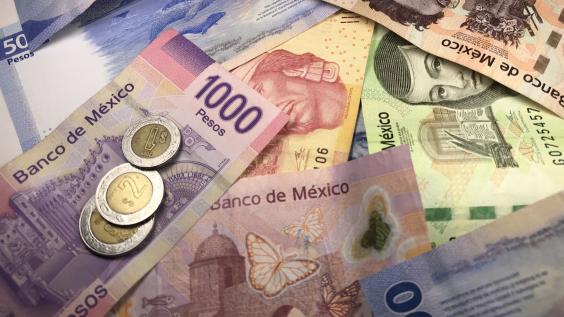
Table of Contents
Jose ivan rodriguez-sanchez, share this publication.
- Download PDF
- Print This Publication
Payan, Tony and Jose Ivan RodriguezSanchez. 2021. Manufacturing, Remittances, Tourism, and Oil: Key Factors for Mexico’s Economy in 2020 and Beyond . Issue brief no. 04.09.21. Rice University’s Baker Institute for Public Policy, Houston, Texas.
Since Mexican President Andrés Manuel López Obrador began his term in December 2018, the Mexican economy has contracted by approximately 9%, 1 the largest economic decline since 1932 (Figure 1). This collapse is primarily due to the government’s inadequate public health strategy in dealing with COVID19 and the absence of an economic stimulus response to address the effects of the pandemic on the country’s gross domestic product (GDP). There is also a persistent public insecurity problem and a growing climate of uncertainty for investors and businesses due to the federal government’s hostile rhetoric and policies toward the private sector. Finally, the political landscape is not encouraging. López Obrador has opted for a strategy of confrontation with the media, opposition parties, several sectors of civil society, and organizations that handle regulatory issues, transparency, and fiscal policy. This political strategy undermines democracy, weakens the rule of law in Mexico, and diminishes the possibility of a stable environment that could lead to economic recovery.
Figure 1 — Mexican GDP Growth Rate, 2000–2020
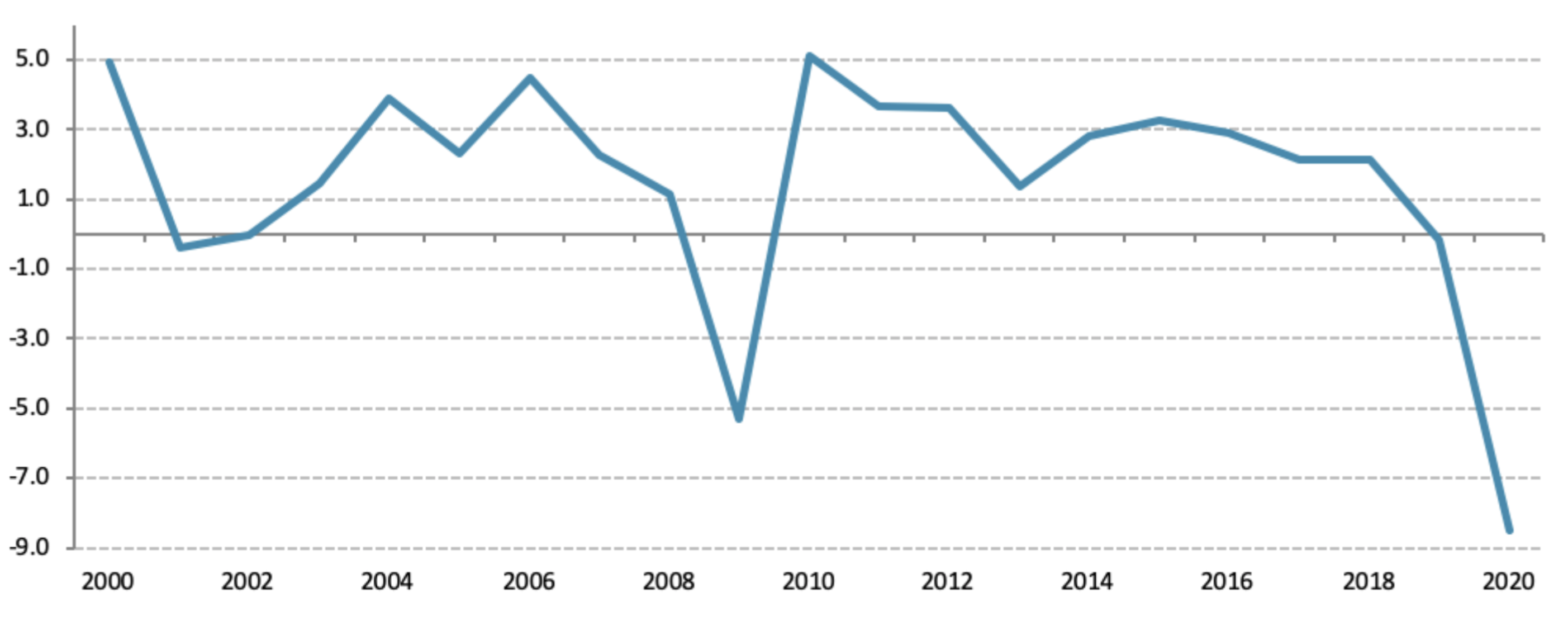
In 2021, predictions indicate that economic performance will not be enough to recover the ground lost in 2019 and 2020. 2 Growth projections are estimated at barely 3.7%. 3 At this rate, the recovery could take until 2024 just to reach 2019 economic levels. 4
The government is creating massive uncertainty—through both its actions, such as questioning the motives of private actors and changing market norms from one day to the next, and its conspicuous inaction, such as the absence of a strategy to deal with public insecurity and its failure to develop an economic stimulus policy in the face of the pandemic. This uncertainty is almost guaranteed to continue. Consequently, investors, who had little confidence in the government before the pandemic, are even more hesitant to invest in Mexico now. Private investment has been declining since 2018, 5 and recovery efforts are also likely to be hindered by the lack of public investment, which has been waning due to the federal government’s austerity policy, 6 underspending in the federal budget, 7 and low government tax collection. 8 Total investment in Mexico has dramatically decreased since 2018 (Figure 2), and this landscape will almost certainly prolong recovery.
Figure 2 — Gross Fixed Investment (as a Percentage of GDP)

The Four Pillars of the Mexican Economy
Faced with this outlook, it is important to examine the four economic pillars that are often credited with bolstering Mexico’s economy in 2019 and 2020. These pillars include the manufacturing sector (especially the automobile sector); remittances, or the money Mexican migrants sent to their families from abroad; the tourism industry, which, despite a notable decrease, continued to be a significant source of income for Mexican citizens; and oil exports from Petróleos Mexicanos (Pemex), Mexico’s state-owned petroleum company. These pillars likely prevented a greater economic contraction during the pandemic and could contribute to recovery efforts in the near-term (from 2022 to 2024). This issue brief looks at each of these pillars, based on the conviction that recovery depends on them.
Manufacturing Sector
Mexico’s economic recovery will depend considerably on the behavior of the manufacturing sector, mainly exports. In recent years, exports from Mexico's manufacturing industry accounted for more than 88% of the nations' total exports. 9 Moreover, in the last five years, this sector has contributed on average more than 17% of the GDP each year. 10
Despite the pandemic and the slump in the U.S. economy (the main market for Mexican exports), the manufacturing sector lost strength only in March and April of 2020, recovering in the following months (Figure 3). Those two months led to a decrease in exports of 8.9% in 2020 compared to 2019 (Figure 4). As the U.S. economy recovers this year, it is expected that Mexican exports will trend upward again, to levels greater than those seen in 2019. This will positively impact the economy. Since exports from this sector are mostly to the United States (more than 80%) and since U.S. manufacturing has recently been recovering, the effects on the Mexican manufacturing sector should be favorable, strengthening Mexico’s economy in the months and years to come.
Figure 3 — Manufacturing Exports in 2020 (Billions of Dollars)
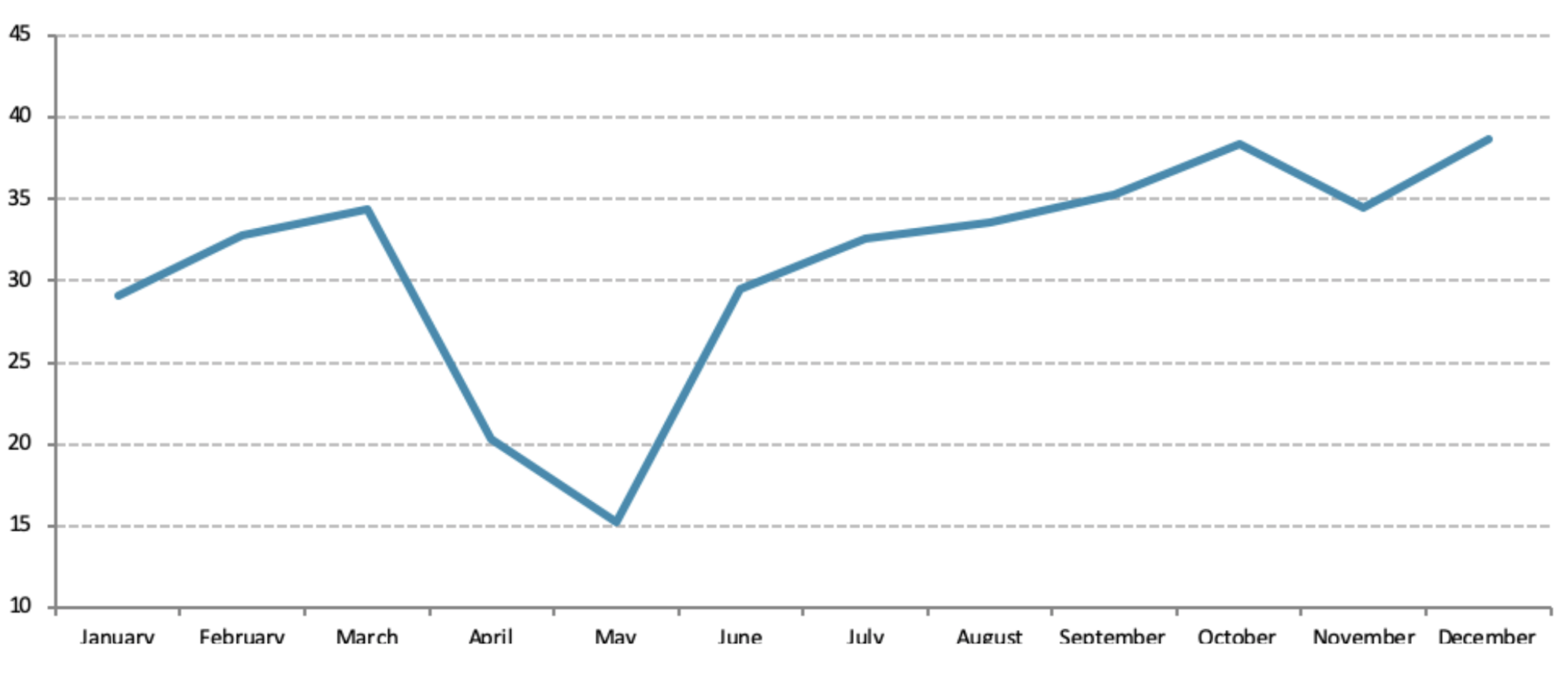
Figure 4 — Manufacturing Exports, 2010–2020 (Billions of Dollars)
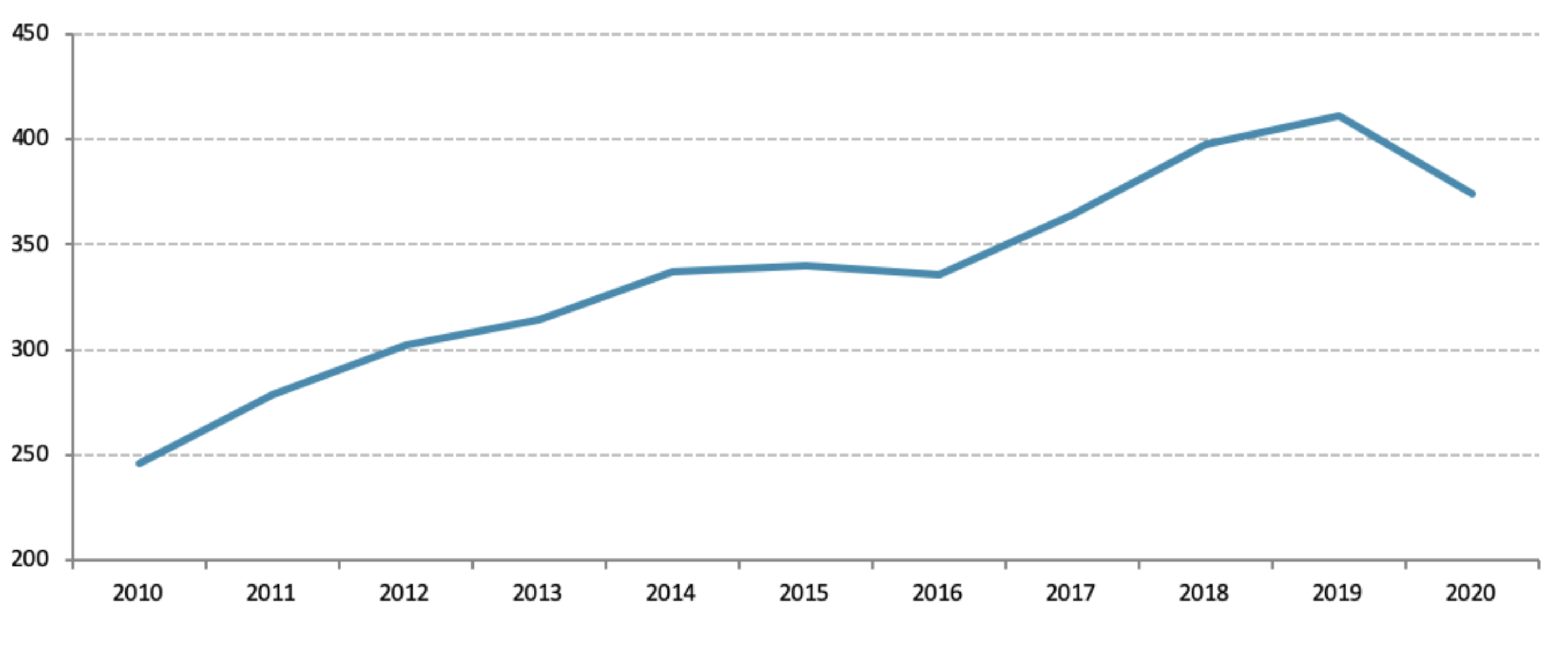
Remittances
Remittances have become one of the most important sources of currency and income in Mexico—the second largest behind the manufacturing sector. They support the domestic consumption of many households that receive them—most of them low-income households.
Remittances sent to Mexico have grown exponentially since 2013 (Figure 5), reaching a historic high in 2020, when they were worth $40.6 billion. That meant an increase of 11.4% over 2019 and 82.1% over 2013. This historic high was significantly driven by the fiscal assistance the United States gave its workers, including many Mexican migrants.
Figure 5 — Remittances (Billions of Dollars)
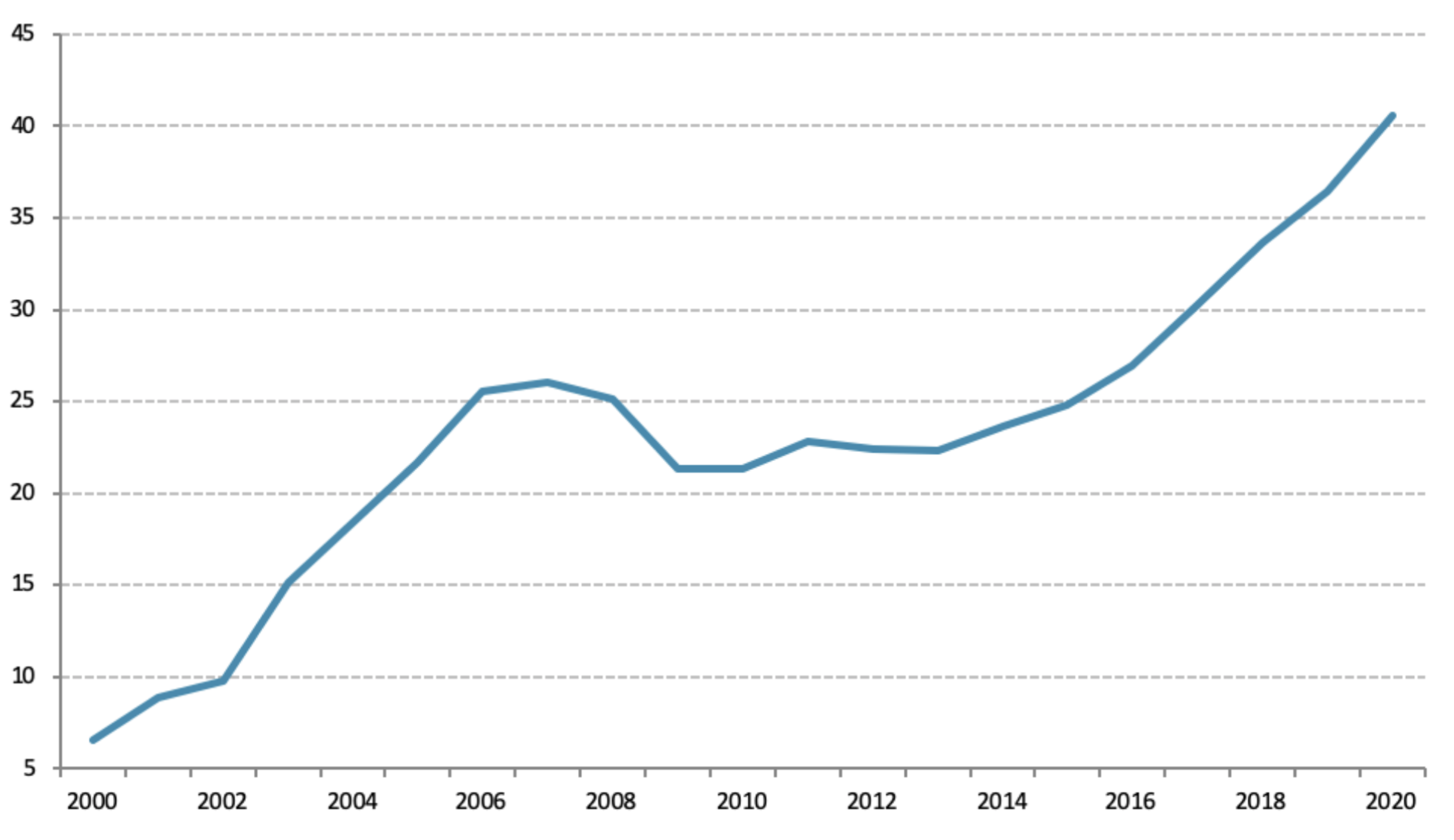
Remittance income as a percentage of GDP in Mexico has also grown considerably since 2013. In 2020, it made up 3.5% of the country’s GDP, a 1.75 percentage point increase over 2013 (Figure 6). The numbers show how important remittances have been to the Mexican economy and why they will be a key factor in boosting Mexico’s economic recovery in 2021.
In fact, remittances have become so important to Mexico that they are as large as the foreign direct investment (FDI) flows the country receives (Figure 6). Whereas remittances have grown in recent years, FDIs have decreased considerably since 2018. In 2020, remittances became the second source of income in the country, only behind the auto industry. FDIs are in third place.
Figure 6 — Income From Remittances and FDIs as a Percentage of Mexico’s GDP, 2010–2020
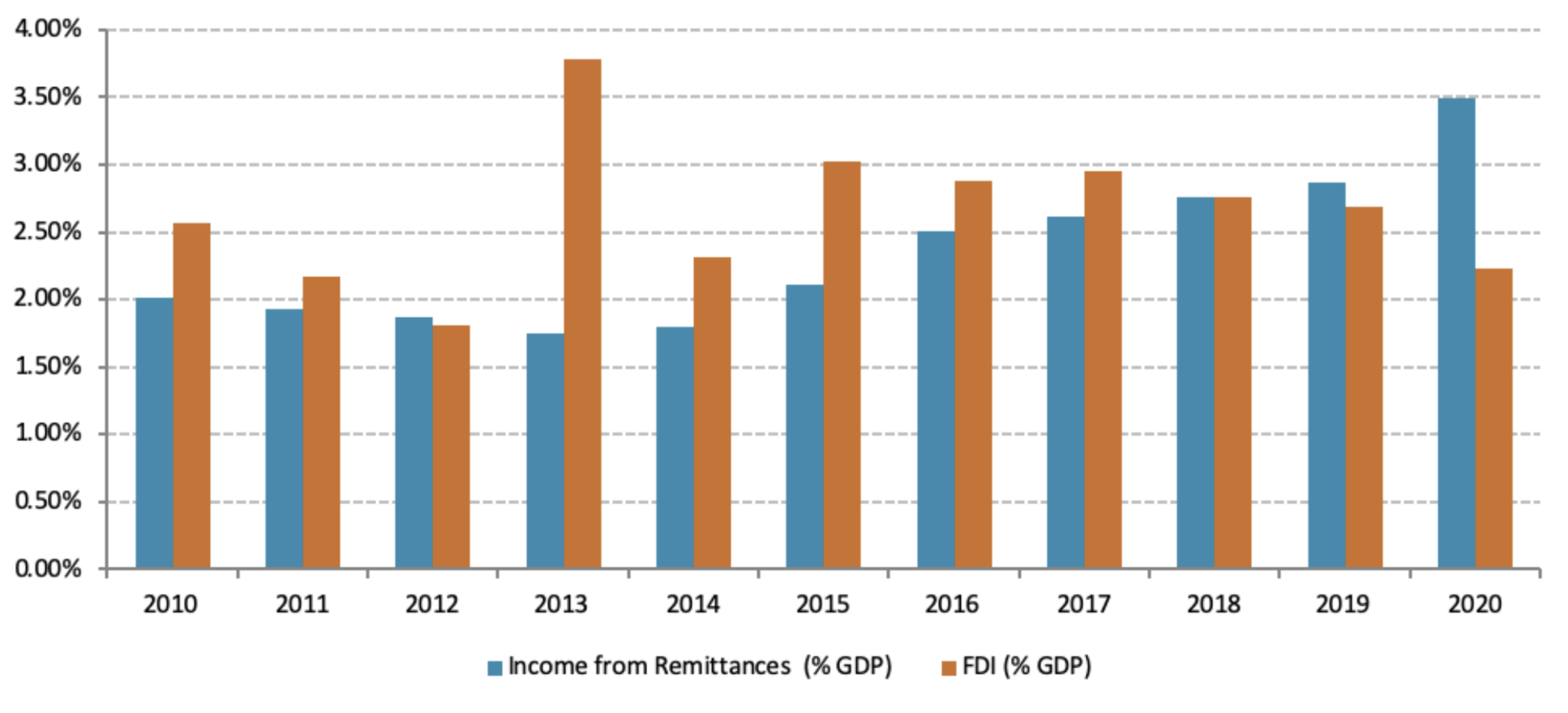
The restrictions placed on non-essential activities to stop the spread of COVID19 have had adverse effects on Mexico’s tourism sector, one of the most important industries for the national economy. In fact, tourism contributed approximately 8.5% to Mexico’s GDP from 2010 to 2019 (Figure 7). Many of Mexico’s tourism services were forced to close down during the pandemic, resulting in the tourism sector contributing less than 5% to the nation’s GDP in 2020. 11 For 2021, predictions indicate that the reactivation of this sector will be very slow, and its contribution to GDP will continue to look similar to that of 2020. In the first half of the year, tourism will continue to be limited by national and international travel restrictions. Still, in the second half, this sector might see some improvement, especially as vaccination rates pick up in countries with people who like to vacation in Mexico, such as the United States and Canada. This might lead to restrictions being lifted on travel to Mexico.
Figure 7 — Contribution of Tourism to Total GDP
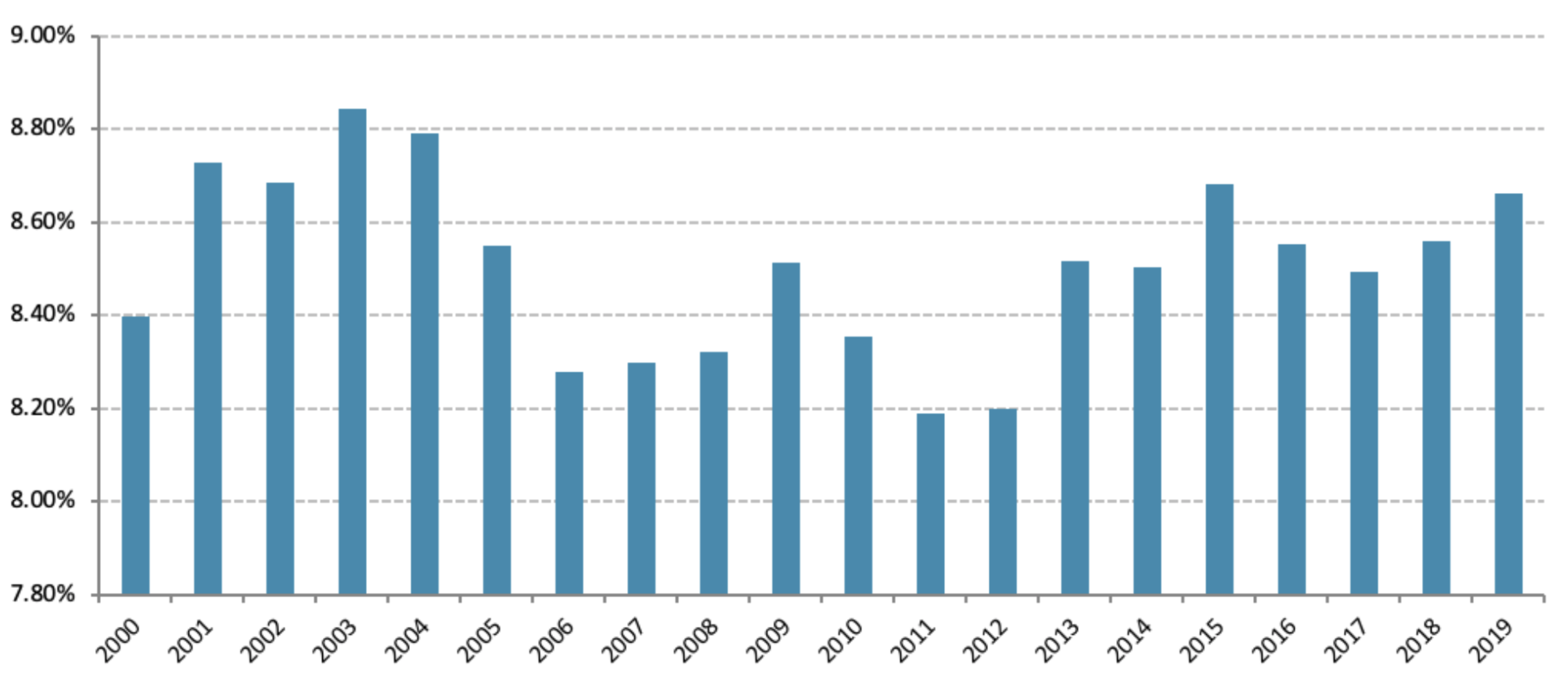
The reduction in tourism has also affected the labor market, since tourism generated 2.3 million jobs (5.5% of the country’s total) in 2019. 12 In 2020, no new jobs were created in this sector, and many that already existed were lost. Meanwhile, the decline in tourism has had a negative effect on currency intake from foreign tourists. Before the pandemic, Mexico was the country with the most economic revenue from foreign travelers out of all countries in Latin America and the Caribbean region. In 2020, Mexico lost 19.8 million international travelers, a 61.2% decrease from 2019 figures (Figure 8). 13 Last year, the economic revenue from foreign visitors was $9.3 billion, a 56.9% reduction compared to the revenue from 2019. This means that Mexico lost approximately $12.3 billion in revenue in 2020, which will have had an enormous impact on the nation’s economy. 14 Since it does not appear that the situation will improve to pre-pandemic levels this year, this sector will continue to have a negative effect on the economy, and recovery will be very slow, taking as many as two to three years.
Figure 8 — Foreign Visitors to Mexico, 2019–2020
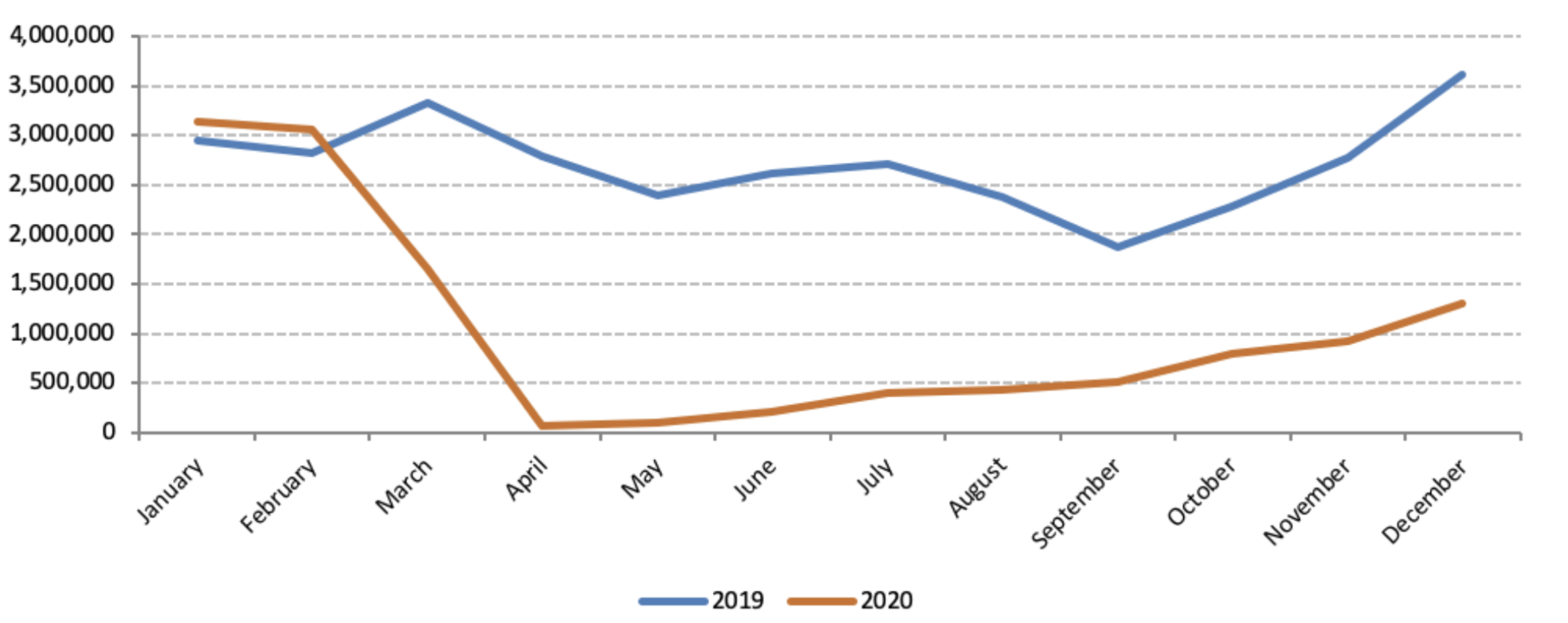
Oil and Pemex
In recent years, Pemex has had a detrimental impact on Mexico’s economy. For decades, the state-owned oil company financed the federal government instead of reinvesting the resources it generated, but those days are over. Even so, President López Obrador has counted on the company to generate economic growth through the supposition that oil production could increase. That has not been the case. If we add in the fact that the federal government has heavily subsidized Pemex so that it could continue working as it has been, with no plans for investment or the development of new technology, the results are catastrophic. For one thing, oil production has gone down in recent years, and despite promises from the government, it has not increased at all in the last two years. The government also does not have a strategic business plan to avoid more losses or to refinance the company.
In 2019, Pemex had a net loss of more than 357 billion pesos ($17.4 billion)—more than double the losses from previous years (Figure 9). In 2020, the price war between the world’s main oil producers and the decrease in demand for oil due to the COVID19 crisis led Pemex to face even higher losses. In fact, Pemex generated an accumulated negative net profit of 605 billion pesos ($30.2 billion) for the third quarter last year. 15 The net annual loss for 2020 is expected to be the highest in the last decade.
Figure 9 — Net Profits for Pemex (Billions of Pesos)
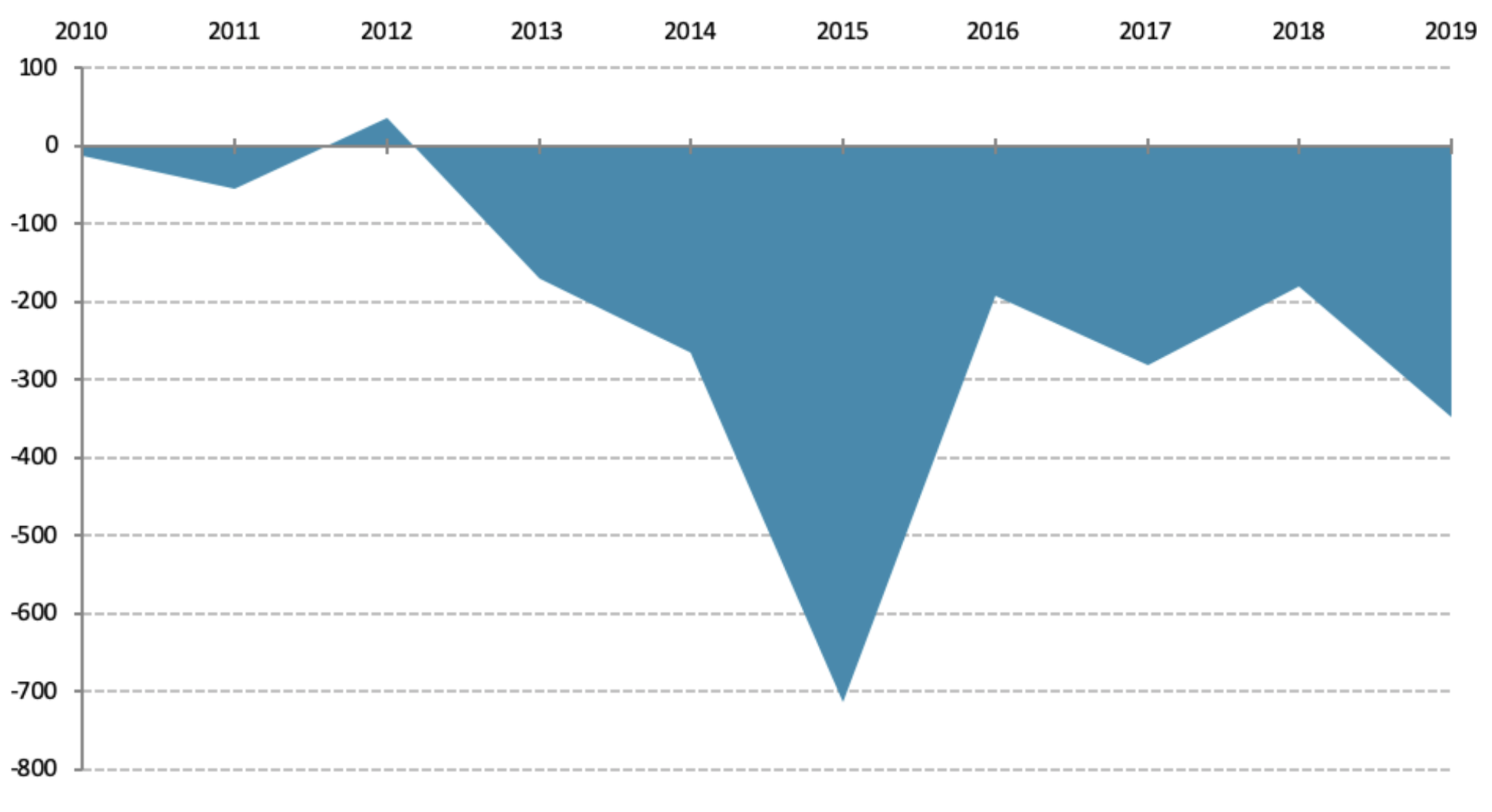
Thus, the recovery of Mexico’s economy in 2021 depends in large part on the fate of this company. If the federal government continues to financially support Pemex, it will seriously affect both the national economy and its fiscal soundness. Putting resources into Pemex is an inefficient use of money with no positive effects on the economy, since there is no plan to restructure it financially. If these resources were used to support businesses and people affected by the pandemic, the positive impact on the economy would be greater. Still, the economic rescue package for the pandemic has been one of the smallest in Latin America, at 1.1% of GDP. 16 It is estimated that support for Pemex in 2021 could cost close to 1.4% of Mexico’s GDP. 17 However, supporting Pemex through a profound restructuring would have a cost of between 10 and 12 GDP points. 18
Thinking optimistically, Pemex could become an important input for the economy if oil prices went up dramatically, but this would also depend on worldwide recovery. For now, however, it is a drag on the country’s GDP.
The recovery of Mexico’s economy will depend in large part on the four key factors analyzed here. The manufacturing sector and remittances are predicted to have a positive effect in bolstering economic recovery. Mexico’s manufacturing sector will likely improve greatly due to the greater dynamism of the U.S. market and the reestablishment of exports from this sector. Remittances will also be a key factor in the economic recovery. Since their expansion has been consistent since 2013, this year it is expected that they will reach a new historic high, continuing to drive the country’s growth. Already in January and February 2021, they showed strong growth. 19
The reactivation of tourism will depend on how efficiently the COVID-19 vaccine is distributed in Mexico and internationally. If it is handled relatively well, tourists will be able to travel without fear of contagion, and restrictions on certain international travelers will likely be lifted. By the second half of the year, it is therefore expected that this sector will start to be reactivated with greater force.
However, Pemex’s financial situation is predicted to continue to deteriorate,20 especially if it does not undergo a restructuring or take on partnerships with the private sector. Because of this, the company will likely contribute to Mexico’s weakening finances in 2021. Pemex is the factor that could have the greatest negative repercussions on the economy—although it will depend in part on the ups and downs of the international market.
At the same time, economic recovery must not rest on these four pillars alone. It should begin with a radical shift in the way the López Obrador administration makes decisions. Yet, changes are unlikely to come any time soon, given López Obrador’s overriding ideological orientation. Unfortunately, this means Mexico’s president will probably continue to make political decisions that will lead to market uncertainty and a much more sluggish and difficult recovery.
1. Jesus Cañas and Chloe Smith, “Mexico’s Economy Shows Signs of Improvement,” Federal Reserve Bank of Dallas, September 23, 2020, https://www.dallasfed.org/research/update/mex/2020/2009.aspx.
2. World Bank Group, Global Economic Perspectives: Latin America and the Caribbean , January 2021, https://pubdocs.worldbank.org/en/515911599838716981/Global-Economic-Prospects-January-2021-Regional-Overview-LAC.pdf.
3. Daniel Zaga, Alessandra Ortiz, and Jesus Leal Trujillo, “Mexico: Rocky road to recovery,” Deloitte Insights , December 21, 2020, https://www2.deloitte.com/us/en/insights/economy/americas/mexico-economic-outlook.html.
4. Arnulfo Rodríguez and Carlos Serrano, “Mexico: The economic recovery will be slow and square root shaped,” BBVA Research, June 19, 2020, https://www.bbvaresearch.com/en/publicaciones/mexico-the-economic-recovery-will-be-slow-and-square-root-shaped/.
5. “Mexico Foreign Direct Investment: 1960-2020 Data, 2021-2023 Forecast,” Trading Economics , https://tradingeconomics.com/mexico/foreign-direct-investment.
6. “Seguirán recortes a gasto de Gobierno en 2021: AMLO,” El Economista , January 4, 2021, https://www.eleconomista.com.mx/politica/Seguiran-recortes-a-gasto-de-Gobierno-en-2021-AMLO-2021-0104-0009.html.
7. Zenyazen Flores, “Subejercicio del Gobierno asciende a 364 mil mdp a octubre; ingresos presupuestarios caen 4.9%,” El Financiero , November 30, 2020, https://www.elfinanciero.com.mx/economia/subejercicio-del-gobierno-asciende-a-364-mil-mdp-a-octubre-ingresos-presupuestarios-caen-4-9/.
8. José Manuel Arteaga, “Tiene México baja recaudación: SAT,” Instituto Mexicano de Contadores Públicos, https://imcp.org.mx/mexico-registra-los-ingresos-tributarios-mas-bajos-de-america-latina-los-cuales-se-ubican-en-9-del-pib-reconocio-el-servicio-de-administracion-tributaria-sat/.
9. Banxico (Banco de México), “Indicators on Merchandise Trade Balance of Mexico,” https://www.banxico.org.mx/SieInternet/consultarDirectorioInternetAction.do?sector=1&idCuadro=CE160&accion=consultarCuadro&l ocale=en.
10. Banxico, “Gross Domestic Product,” https://www.banxico.org.mx/SieInternet/consultarDirectorioInternetAction.do?sector=2&idCuadro=CR201&accion=consultarCuadro &locale=en.
11. Ana M. Lopez, “Mexico: Impact of COVID-19 on the tourism sector 2020,” Statista , August 28, 2020, https://www.statista.com/statistics/1124221/coronavirus-impact-tourism-sector-mexico/.
12. “Resultados de la Cuenta Satélite del Turismo de México 2019 (CSTM),” Secretaria del Turismo y Dataur, 2019, https://www.datatur.sectur.gob.mx/SiteCollectionImages/SitePages/ProductoDestacado3/ CSTM_2019.jpg
13. Unidad de Política Migratoria de la Secretaría de Gobernación, “Boletines Estadísticos: Registro de Entradas, 2020,” http://www.politicamigratoria.gob.mx/es/PoliticaMigratoria/CuadrosBOLETIN?Anual=20 20&Secc=1.
14. INEGI (National Institute of Statistics and Geography), “Encuesta de Turismo de Internación (ETI),” https://www.inegi.org.mx/programas/eti/2018/#Tabulados.
15. Karol García, “Pemex acumula pérdida de 605,176 millones de pesos hasta septiembre,” October 28, 2020, El Economista , https://www.eleconomista.com.mx/empresas/Pemex-acumula-perdida-de-605176-millones-de-pesos-hasta-septiembre---20201028-0061.html.
16. CEPAL (The United Nations Economic Commission for Latin America and the Caribbean), “Enfrentar los efectos cada vez mayores del COVID-19 para una reactivación con igualdad: nuevas proyecciones,” July 15, 2020, https://repositorio.cepal.org/bitstream/handle/11362/45782/4/ S2000471_es.pdf.
17. Guillermo Castañares, “Recuperación de México está sujeta a medidas de apoyo a personas y empresas,” El Finaciero , January 13, 2021, https://www.elfinanciero.com.mx/economia/recuperacion-sujeta-a-medidas-de-apoyo.
18. Fundación de Estudios Financieros, “Análisis Financiero de la Evolución de Pemex, 2009-2019, Evaluación de la posibilidad de un Impacto Sistémico en México,” 2020, https://www.fundef.mx/wp-content/uploads/2021/02/Doc.AnalisisFinancieroPemexFUNDEF.pdf.
19. Juan José Li Ng, “México: Estimaciones del flujo de remesas por entidad federativa para 2021,” BBVA Research, March 1, 2021, https://www.bbvaresearch.com/publicaciones/mexico-estimaciones-del-flujo-de-remesas-por-entidad-federativa-para-2021/.
20. Fitch Ratings, “Petroleos Mexicanos (PEMEX),” Ratings Report, September 21, 2020, https://www.fitchratings.com/research/corporate-finance/petroleos-mexicanos-pemex-21-09-2020.
This material may be quoted or reproduced without prior permission, provided appropriate credit is given to the author and Rice University’s Baker Institute for Public Policy. The views expressed herein are those of the individual author(s), and do not necessarily represent the views of Rice University’s Baker Institute for Public Policy.
Related Research

The Power Problem: Nearshoring and Mexico’s Energy Sector

What Does Mexico’s Impending Return to Single-Party Governance Mean for Attracting FDI?

A New Chapter in Trade: Preparing for the Landmark Review of the USMCA
Licence or Product Purchase Required
You have reached the limit of premium articles you can view for free.
Already have an account? Login here
Get expert, on-the-ground insights into the latest business and economic trends in more than 30 high-growth global markets. Produced by a dedicated team of in-country analysts, our research provides the in-depth business intelligence you need to evaluate, enter and excel in these exciting markets.
View licence options
Suitable for
- Executives and entrepreneurs
- Bankers and hedge fund managers
- Journalists and communications professionals
- Consultants and advisors of all kinds
- Academics and students
- Government and policy-research delegations
- Diplomats and expatriates
This article also features in The Report: Mexico 2019 . Read more about this report and view purchase options in our online store.

Mexican government's tourism strategy aims to promote sustainable and inclusive growth
Mexico | Tourism
Mexican officials are turning to the tourism sector in a drive to create a more inclusive and sustainable economy based on technological advancement, as well as value-added products and services. The National Development Plan (Plan Nacional de Desarrollo, PND) 2019-24, released by President Andrés Manuel López Obrador – commonly known as AMLO – aims to promote the responsible use of resources and reach 6% economic growth by 2024. It is expected to have a wide impact on the overall Mexican economy, and the tourism sector is no different. Tehe plan seeks to position Mexico as a popular, sustainable and inclusive destination and will use tourism’s contribution as a percentage of GDP to track progress. The government is also investing heavily in infrastructure to accommodate the growing number of tourists, from the Maya Train – a tourist connection running between the states of Quintana Roo, Yucatán, Campeche and Chiapas – to a new airport in Mexico City to complement Mexico City International Airport (Aeropuerto Internacional de la Ciudad de México, AICM), which is over capacity. New hotels and resorts are opening as a result of the infrastructure development, highlighting the central role tourism plays in supporting economic growth.
Tourism Strategy
Mexico’s plans for tourism go beyond the PND 2019-24. In February 2019 AMLO announced the National Tourism Strategy (Estrategia Nacional de Turismo, ENT) 2019-24 to complement the overarching economic development plan. The ENT 2019-24 focuses on five pillars: the integration and development of the south-east regions with high-impact infrastructure projects; the regionalisation of destinations into macro-regions to encourage wider development; efforts to increase tourist spending; the utilisation of tourism to generate economic wealth for Mexicans in underdeveloped locations; and the diversification of source markets.
Under this umbrella, there will be five major projects to help achieve the goals of the ENT 2019-24. The first will be the Maya Train, to which the government has allocated MXN65bn ($3.4bn). The second will be to group tourist sites into eight regions to encourage those visiting Mexico City, for instance, to explore other destinations nearby. The third project will target domestic tourists and will seek to reduce seasonality in the segment. To this end, the state is introducing the Disfruta México (Enjoy Mexico) marketing strategy that will encourage tour operators and strategic partners to offer low-cost tourist packages. For the fourth, two programmes were proposed to diversify source markets. Operación Toca Puertas (Operation Open Doors) will focus on attracting tourists from countries with high purchasing power such as those from the US, the UK, the EU, the UAE, India, China, South Korea, Japan and Russia. The Reencuentro con mis Raíces (Reunion with my Roots) strategy will target Mexican-Americans.
Lastly, the fifth project will see the implementation of multi-sector endeavours to ensure the areas around tourist locations meet basic infrastructure needs such as housing, drinking water, drainages and electricity. “We want to support tourism and, at the same time, support the regions that have lagged in terms of growth and in terms of development,” AMLO told local media.
Flying High
In a referendum held in October 2018 voters rejected the completion of the partially built multibillion-dollar new airport 25 km north-east of Mexico City, which caused work on the facility to come to a halt. However, 69% of voters rejected the New Mexico International Airport and only 1m people – or around 1% of the total electorate – participated. Before taking office the president had criticised the airport as an improper use of resources with significant environmental impact. He then proposed building an airport in Santa Lucía, around 50 km north of the existing AICM, which is over capacity. At a cost of MXN78.6bn ($444.7m), the proposed Santa Lucía airport was expected to have a maximum annual passenger capacity of 20m to offset AICM’s passenger load.
Because of the distance between Santa Lucía and AICM, however, authorities estimate there would need to be an additional MXN11.9bn ($615.3m) invested to boost connectivity between the two facilities. Central to this would be a new 45.7-km road connecting the two airports with exclusive lanes for bus transfers. However, there remain concerns that the distance will make the airports inconvenient and uncompetitive. “If you were flying to Mexico City internationally and have to go to Santa Lucía to fly domestically to Aguascalientes, it would be faster to drive or take a bus to Aguascalientes, which is not very comfortable for someone who has already travelled quite a distance,” Beat Wille, general country manager for Mexico at BCD Travel, told OBG.
Santa Lucía is one of three airports that the authorities have proposed developing to boost capacity and serve the capital city. It may operate alongside AICM and an international terminal in the state capital of Toluca. However, in August 2019 a judge issued a ruling that suspended construction. Later that same month a judge overruled the environmental approval given to the Santa Lucía airport by the Ministry of Environment and Natural Resources. The path forward is unclear after a series of legal challenges and setbacks, but in September 2019 AMLO told local media that he expects soon there will be “no legal obstacle” to its construction.
Tourist Train
The Maya Train project, already under way, will construct seven train lines running a total of 1470 km at a cost of MXN150bn ($7.8bn). An estimated MXN65bn ($3.4bn) will come directly from the state and the remaining funds from private and social enterprises. The railway will transport tourists, as well as freight, across the region. Importantly, it will allow the tourist economy in Cancún and other resorts to spill into less prosperous areas. The train was originally conceived to have 15 stations, but in August 2019 officials from the National Fund for the Development of Tourism announced it would add three more stations: Cancún Centro and Chetumal in Quintana Roo, and El Triunfo in Tabasco. In September 2019 the government announced it was preparing to invite bids on the project. While the project is an opportunity for tourists to explore more of Mexico, it also makes acute the need for increased investment in basic infrastructure and services. “At the very least there needs to be services like running water and bathrooms, and many of our archaeological sites are in jungle areas,” Nicolás Cano Ibarra, director of strategic planning at the Ministry of Tourism, told OBG. “They offer only basic amenities and are poorly connected to nearby towns and villages. Establishing better connections to these cultural heritage sites is essential.” The challenge, he said, is to construct the facilities needed to make the sites tourist-friendly without causing harm to the environment and communities living there.
Resort Living
Hotel and resort facilities are expanding to meet the increased demand from the improved tourist infrastructure. There will be 352 new hotels opening between 2019 and 2022, according to consulting firm CBRE. Luxury all-inclusive resorts continue to dominate the new openings. In Los Cabos, Zadún, a Ritz-Carlton Reserve development, opened in the spring of 2019, with 115 rooms, suites and villas, all with butler services and terraces overlooking the sea. In April of that year the Hotel Nobu Los Cabos opened, with 200 rooms. In November 2019 the resort city will see the opening of the Four Seasons Resort Los Cabos in Costa Palmas, which will have 145 rooms, three bars and restaurants, four swimming pools and a spa. However, the expansions are not only targeting couples and others looking for a relaxing beach holiday. In 2020 a Nickelodeon resort is expected to open, with 276 ocean-front suites, four themed penthouses, and a 500,000-sq-feet area with a water park and playground.
Investment in tourism and supporting infrastructure such as utilities, transport and accommodation is expected to fuel continued growth in the sector, which despite some turbulence, has expanded every year from 2011 to 2018. The successful implementation of the government’s programmes under the PND is likely to determine whether officials can transform tourism growth into equitable long-term economic expansion.
Request Reuse or Reprint of Article
Read More from OBG
Mexico's Texistepec industrial complex to help strengthen global supply chains Once fully operational, the 300-km-long Interoceanic Corridor across Mexico’s Isthmus of Tehuantepec is expected to complement the Panama Canal and transport goods representing 1% of global GDP. One of the largest of the industrial complexes, the 500-ha Centro ProIstmo at Texistepec, will add value to the raw materials and electronic components produced in Mexico and abroad, helping make the corridor one of the most important trading nodes in the Western Hemisphere. …

Khalid Jasim Al Midfa, Chairman, Sharjah Commerce and Tourism Development Authority (SCTDA) In this Global Platform video, Oxford Business Group speaks with Khalid Jasim Al Midfa, Chairman, Sharjah Commerce and Tourism Development Authority (SCTDA) about Sharjah’s strategies for fostering tourism growth by striking a balance between cultural appreciation and sustainability. In 2022 tourism constituted over 9% of the UAE's GDP and contributed around 10% to non-oil GDP in the emirate of Sharjah, which is positioning itself as a family and environmentally friendly destination. Sharjah, …

Ghana underscores its pivotal role as a regional and international trade partner Oxford Business Group has launched The Report: Ghana 2024. This latest edition offers a detailed analysis of the country’s economic trajectory, focusing on fiscal consolidation and structural reforms. It examines the nation's progress in managing expenditure and debt, alongside the impact of IMF programmes and strategic reforms aimed at enhancing revenue mobilisation. Despite challenges such as financial sector stress and the upcoming elections, Ghana remains optimistic…

Register for free Economic News Updates on Mexico
“high-level discussions are under way to identify how we can restructure funding for health care services”, related content.
Featured Sectors in Mexico
- Mexico Agriculture
- Mexico Banking
- Mexico Construction
- Mexico Cybersecurity
- Mexico Digital Economy
- Mexico Economy
- Mexico Education
- Mexico Energy
- Mexico Environment
- Mexico Financial Services
- Mexico Health
- Mexico Industry
- Mexico Insurance
- Mexico Legal Framework
- Mexico Logistics
- Mexico Media & Advertising
- Mexico Real Estate
- Mexico Retail
- Mexico Safety and Security
- Mexico Saftey and ecurity
- Mexico Tourism
- Mexico Transport
Featured Countries in Tourism
Popular Sectors in Mexico
Popular Countries in Tourism
- Indonesia Tourism
- Malaysia Tourism
- The Philippines Tourism
- Thailand Tourism
- Oman Tourism
Featured Reports in Mexico
Recent Reports in Mexico
- The Report: Mexico 2019
- The Report: Mexico 2018
- The Report: Mexico 2017
- The Report: Mexico 2015
- The Report: Mexico 2014
Privacy Overview

How Tourism in Mexico Can Reduce Poverty
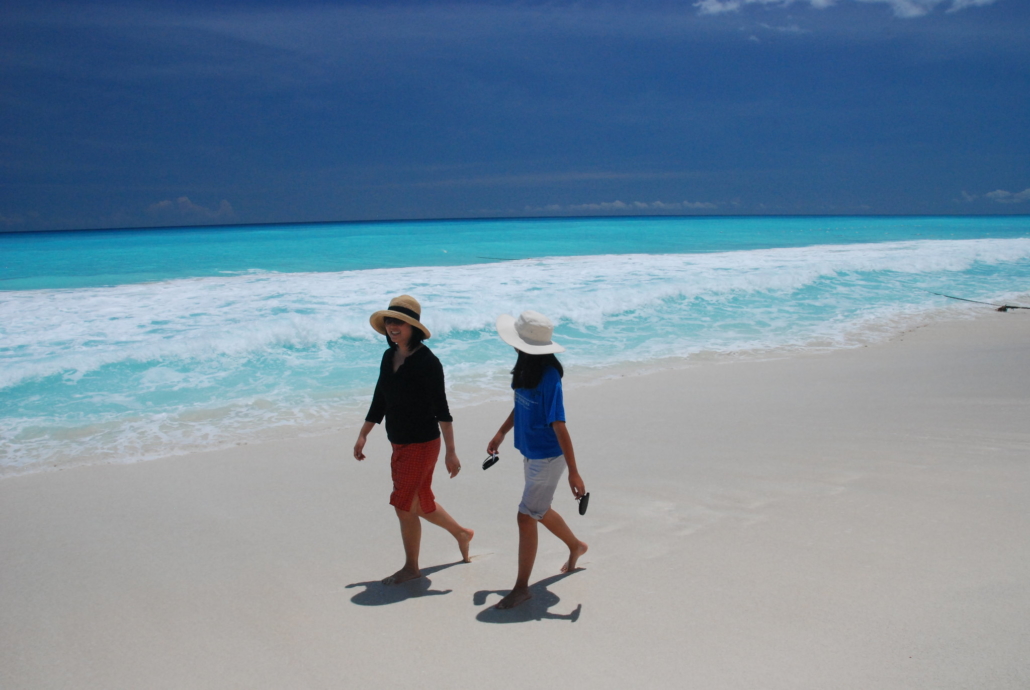
An Overview of Poverty in Mexico
The World Bank has reported that Mexico has struggled to stimulate economic growth and lift its large proportion of disadvantaged citizens out of poverty. In 2014, the National Council for the Evaluation of Social Development (CONEVAL) revealed that 46.2% of Mexicans lived in multidimensional poverty and Reuters reported a 44% national poverty rate in 2020.
Income and regional inequality are some of Mexico’s most significant challenges. According to a 2021 study, data from 1989 to 2016 shows that the most impoverished 10% of the population have never had an income share higher than 2%. In addition, poverty affects rural areas the most severely. With tourism raking in approximately $25 billion for the Mexican economy in 2019, according to CNN, the potential of the industry to solve this issue is massive.
3 Ways that Tourism Alleviates Poverty
- It stimulates the local economy. According to globalEDGE, tourism provides a large amount of revenue to small businesses, such as restaurants, hotels and shopping malls, because of visitors’ desires to experience local food and products. A 2015 study from South Africa also found that increased investment in the tourism industry serves to diversify the local economies of a country, which can be a positive step for areas with declining “traditional” industries, like manufacturing.
- It stimulates the national economy. Tourism can be a significant contributor to the GDP of a country — the global tourism industry accounted for 10.3% of the global GDP in 2019 .
- It creates jobs for locals. One of the key benefits of the tourism sector is that goods are consumed where they are produced , meaning that businesses can count on visitors to consume local goods and services. Tourism can create both full-time and part-time employment for people living in the area who can capitalize on their local knowledge to offer an authentic cultural experience. The industry also generates job opportunities that do not require extensive training, which can be invaluable to people who have little formal education or who live in disadvantaged circumstances. In countries like Mexico, many people have employment in tourism. TravelPulse reports that 4.49 million Mexicans work in the sector as of 2022.
Investment in Tourism in Mexico
In 2019, President Andrés Manuel López Obrador announced a new National Tourism Strategy in the hopes of achieving “6% economic growth by 2024” and promoting sustainable tourism practices to benefit a larger proportion of Mexican citizens. The strategy includes infrastructure projects aimed at spreading tourism into the southeast of the country, investments that will increase spending by visitors and efforts to make tourism a more lucrative industry for Mexicans living in disadvantaged areas.
One of the infrastructure projects is the Maya Train, a railway line that will run from popular destinations like Cancún and stop off in areas where tourism has traditionally been low, allowing tourists to visit a more diverse range of places and spread the wealth that the industry produced more evenly across the country. The project was originally estimated to cost around $150 billion Mexican pesos, or $7.8 billion USD.
Although plans for the construction of the railway lines and stations have suffered some setbacks , the Mexican government stated in a press release on October 17, 2022, that the construction of a station in Yucatán had begun. The Yucatán Peninsula is known for several interesting archaeological sites and the rail line will allow tourists to easily visit these cultural landmarks and support local businesses.
On a regional level, the state of Quintana Roo has spent the quieter period of the COVID-19 pandemic honing a new branding strategy. Cancún is its most popular destination, but the state is making efforts to expand tourists’ horizons. In an interview with Skift, the director of strategic planning for the state’s Tourism Promotion Council, Benjamin Jimenez , explained that the council is focusing on promoting a wider range of options than just sun and sand. This strategy will hopefully entice tourists to visit areas that are culturally significant but not typically popular with foreign visitors, pumping money into local economies and small businesses.
Looking Ahead
The future is bright for tourism in Mexico after a tough few years amid the COVID-19 pandemic. There is also evidence that the Mexican government is looking to expand its tourist industry into deprived areas, which will provide a funding surge, not just from tourist spending but from government and foreign investment too. Perhaps this could be the boost that Mexico needs to eliminate poverty for good.
– Abbi Powell Photo: Flickr
“The Borgen Project is an incredible nonprofit organization that is addressing poverty and hunger and working towards ending them.”
-The Huffington Post
Inside the borgen project.
- Board of Directors
Get Smarter
- Global Poverty 101
- Global Poverty… The Good News
- Global Poverty & U.S. Jobs
- Global Poverty and National Security
- Innovative Solutions to Poverty
- Global Poverty & Aid FAQ’s
Ways to Help
- Call Congress
- Email Congress
- 30 Ways to Help
- Volunteer Ops
- Internships
- Courses & Certificates
- The Podcast
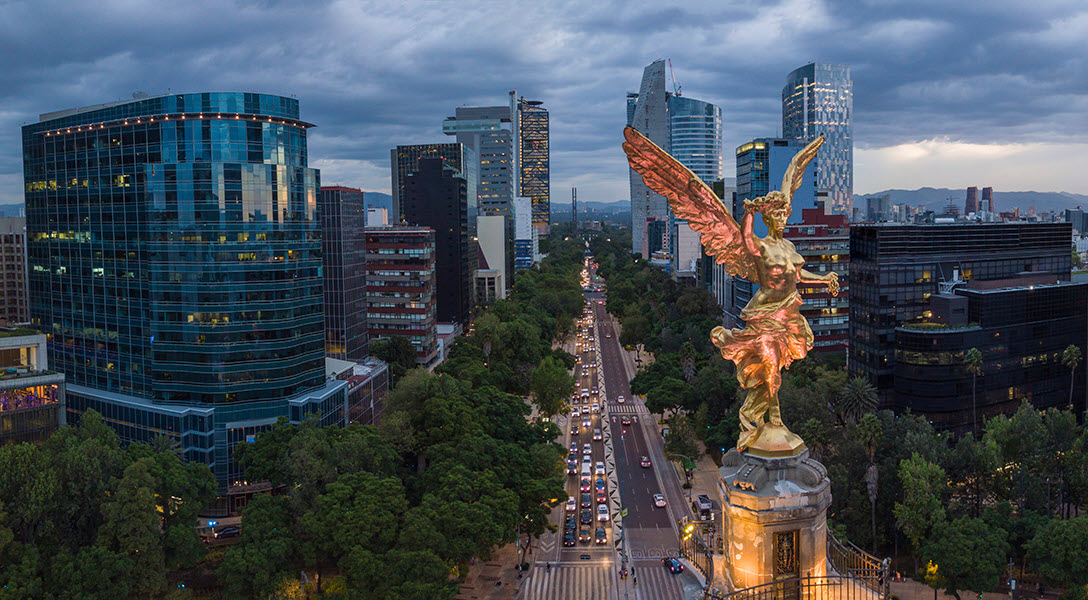
Mexico’s economy continues growing through second quarter
July 03, 2024

November 23, 2022
Mexico’s economy continued growing steadily through the second quarter, according to the monthly GDP proxy. However, high inflation and the recent increase in political uncertainty remain headwinds for the Mexican economy. Despite these challenges, the consensus forecast for 2024 GDP growth (fourth quarter/fourth quarter), compiled by Banco de México, remained around 2 percent in May ( Table 1 ).
The latest data available show industrial production was flat, while exports and retail sales increased. Employment also grew but at a slower rate than the previous month. The peso lost value against the dollar, and inflation remained elevated.
Output steadily increasing
The global economic activity index (IGAE)—the monthly proxy for GDP growth—rose a mere 0.3 percent month over month in May after falling 0.3 percent in April ( Chart 1 ). Both the goods-producing sector (including manufacturing, construction and utilities) and service-related activities (including trade and transportation) increased 0.4 percent. The IGAE was up 2.0 percent year over year.

Industrial production flat
The three-month moving average of Mexico’s industrial production (IP) index, which includes manufacturing, construction, oil and gas extraction, and utilities, did not change in April ( Chart 2 ). Manufacturing IP declined 0.1 percent. North of the border, the three-month moving average of U.S. IP was up slightly (0.2 percent) in May.

Exports tick up
The three-month moving average of total Mexico exports edged up 0.1 percent in April ( Chart 3 ). While the much-larger manufacturing sector increased 0.6 percent, oil exports fell 9.3 percent in April. Total exports fell 1.1 percent during the first four months of 2024 compared with the same period a year ago, with oil exports down 8.7 percent and manufacturing down 0.7 percent.

Retail sales rise in April
The three-month moving average of real retail sales increased 0.3 percent in April, the latest data available ( Chart 4 ). In addition, the smoothed retail sales index was up 0.5 percent year over year.

Payroll expansion slows
Formal sector employment, meaning jobs with government benefits and pensions, grew an annualized 1.9 percent (35,000 jobs) in May, after strong growth the previous month ( Chart 5 ). Total employment, representing 59.1 million workers and including informal sector jobs, was up 1.1 percent year over year in the first quarter. The unemployment rate held steady at 2.6 percent in April.

Peso loses ground against the dollar in June
The Mexican currency averaged 18.2 pesos per dollar in June, down from May’s value of 16.8 pesos per dollar ( Chart 6 ). The peso has been trending up steadily since early 2022; however, it depreciated 8 percent in June as a result of volatility after Mexico’s presidential election and the possibility of a judicial reform proposed by the outgoing administration.

Peso real exchange rate above long-term average
The real exchange rate measures how expensive a foreign country is relative to the home country at the prevailing nominal exchange rate. Therefore, a country’s real exchange rate is often expected to gravitate toward its long-term average in order to avoid significant trade and foreign investment distortions. Mexico’s real exchange rate was 27 percent above its long-term average as of April 2024 ( Chart 7 ). The recent depreciation of the peso in June could help reduce that gap.

Remittances to Mexico edge up in April
The three-month moving average of real remittances to Mexico increased 0.7 percent in April after falling 2.6 percent in March ( Chart 8 ). Total remittances through April were down 0.3 percent compared with the same period a year ago. The U.S. economy is expected to experience slower employment growth this year, which may further impact the capacity of Mexicans working abroad to send money back home.

Inflation continues to be elevated
Mexico’s CPI moved slightly down to 4.7 percent in May from the prior 12 months, less than the 4.8 percent reading in April ( Chart 9 ). CPI core inflation, which excludes food and energy, continued slowing, to 4.2 percent. CPI core inflation has slowed since early 2023; however, services inflation persists, keeping overall inflation above the central bank’s 3.0 percent target rate. In June, Mexico’s central bank kept the overnight rate constant at 11.0 percent. In the statement, the central bank said the disinflationary process is likely to continue due to the ongoing weakness in the economy. However, the recent peso depreciation is pushing up the inflation forecasts, they noted.

About the authors

Jesus Cañas is a senior business economist in the Research Department of the Federal Reserve Bank of Dallas.

Diego Morales-Burnett is a research analyst in the Research Department at the Federal Reserve Bank of Dallas.
Travel, Tourism & Hospitality
Industry-specific and extensively researched technical data (partially from exclusive partnerships). A paid subscription is required for full access.
- Share of tourism contribution to GDP in Mexico 2010-2022
Tourism sector as a percentage of gross domestic product in Mexico from 2010 to 2022
To access all Premium Statistics, you need a paid Statista Account
- Immediate access to all statistics
- Incl. source references
- Download as PDF, XLS, PNG and PPT
Additional Information
Show sources information Show publisher information Use Ask Statista Research Service
December 2023
2010 to 2022
based on current prices
*Preliminary figures. Data prior to 2021 was retrieved from previous reports.
Other statistics on the topic Travel and tourism in Mexico
- Leading global countries in the Travel & Tourism Development Index 2023
- Inbound tourism volume in Mexico 2016-2022
- Inbound tourism spending in Mexico 2016-2022
Accommodation
- Largest hotel companies in Mexico 2022, based on revenue

To download this statistic in XLS format you need a Statista Account
To download this statistic in PNG format you need a Statista Account
To download this statistic in PDF format you need a Statista Account
To download this statistic in PPT format you need a Statista Account
As a Premium user you get access to the detailed source references and background information about this statistic.
As a Premium user you get access to background information and details about the release of this statistic.
As soon as this statistic is updated, you will immediately be notified via e-mail.
… to incorporate the statistic into your presentation at any time.
You need at least a Starter Account to use this feature.
- Immediate access to statistics, forecasts & reports
- Usage and publication rights
- Download in various formats
* For commercial use only
Basic Account
- Free Statistics
Starter Account
- Premium Statistics
The statistic on this page is a Premium Statistic and is included in this account.
Professional Account
- Free + Premium Statistics
- Market Insights
1 All prices do not include sales tax. The account requires an annual contract and will renew after one year to the regular list price.
Statistics on " Travel and Tourism in Mexico "
- Countries in the Americas with the highest inbound tourist arrivals 2019-2022
- Number of tourism jobs in Latin American countries 2022
- Number of Latin American and Caribbean World Heritage Sites 2022, by country
- Leading countries in the Americas in the Travel & Tourism Competitiveness Index 2023
- Tourism GDP in Mexico 2010-2022
- Tourism GDP in Mexico 2022, by activity
- Tourism FDI in Mexico 2010-2022
- Tourism establishments in Mexico 2010-2020
- Quarterly tourism workforce in Mexico 2018-2023
- Per capita spending of inbound tourists in Mexico 2016-2022
- Number of domestic hotel guests in Mexico 2010-2020
- Domestic tourism spending in Mexico 2010-2022
- Cruise passenger traffic in Mexico 2022, by port
- Most visited archeological sites in Mexico 2022
- Quarterly accommodation and holiday package spending in Mexico 2016-2020
- Number of hotels in Mexican states 2023
- Hotel room occupancy in Mexico 2010-2022
- Hotel room occupancy rate in Mexico 2019-2022, by type of location
- Occupancy rates in key Mexican hotel markets 2022
- Main tourist destinations in Mexico 2020-2022, by number of occupied rooms
- Top Mexican resorts 2023, by user ratings
- Most popular holiday destination type for Mexicans 2022
- Most popular domestic holiday destinations in Mexico 2022
- Favorite aspects of domestic holiday trips for Mexicans 2022
- Favorite aspects of outbound holiday trips for Mexicans 2022
- Favorite type of holidays for Mexicans 2022
- Breakdown of Mexican holidaymakers 2022, by travel companion
Other statistics that may interest you Travel and Tourism in Mexico
- Premium Statistic Countries in the Americas with the highest inbound tourist arrivals 2019-2022
- Basic Statistic Number of tourism jobs in Latin American countries 2022
- Basic Statistic Number of Latin American and Caribbean World Heritage Sites 2022, by country
- Premium Statistic Leading global countries in the Travel & Tourism Development Index 2023
- Premium Statistic Leading countries in the Americas in the Travel & Tourism Competitiveness Index 2023
Key economic figures
- Premium Statistic Share of tourism contribution to GDP in Mexico 2010-2022
- Premium Statistic Tourism GDP in Mexico 2010-2022
- Premium Statistic Tourism GDP in Mexico 2022, by activity
- Premium Statistic Tourism FDI in Mexico 2010-2022
- Premium Statistic Tourism establishments in Mexico 2010-2020
- Premium Statistic Quarterly tourism workforce in Mexico 2018-2023
Tourism volume and expenditures
- Premium Statistic Inbound tourism volume in Mexico 2016-2022
- Premium Statistic Inbound tourism spending in Mexico 2016-2022
- Premium Statistic Per capita spending of inbound tourists in Mexico 2016-2022
- Premium Statistic Number of domestic hotel guests in Mexico 2010-2020
- Premium Statistic Domestic tourism spending in Mexico 2010-2022
- Premium Statistic Cruise passenger traffic in Mexico 2022, by port
- Premium Statistic Most visited archeological sites in Mexico 2022
- Premium Statistic Quarterly accommodation and holiday package spending in Mexico 2016-2020
Hotel industry
- Premium Statistic Number of hotels in Mexican states 2023
- Premium Statistic Largest hotel companies in Mexico 2022, based on revenue
- Premium Statistic Hotel room occupancy in Mexico 2010-2022
- Premium Statistic Hotel room occupancy rate in Mexico 2019-2022, by type of location
- Premium Statistic Occupancy rates in key Mexican hotel markets 2022
- Premium Statistic Main tourist destinations in Mexico 2020-2022, by number of occupied rooms
- Basic Statistic Top Mexican resorts 2023, by user ratings
Traveler preferences
- Premium Statistic Most popular holiday destination type for Mexicans 2022
- Premium Statistic Most popular domestic holiday destinations in Mexico 2022
- Premium Statistic Favorite aspects of domestic holiday trips for Mexicans 2022
- Premium Statistic Favorite aspects of outbound holiday trips for Mexicans 2022
- Premium Statistic Favorite type of holidays for Mexicans 2022
- Premium Statistic Breakdown of Mexican holidaymakers 2022, by travel companion
Further related statistics
- Premium Statistic Tourism balance over GDP Indonesia 2014-2020
- Premium Statistic Tourism openness over GDP in Russia 2010-2020
- Premium Statistic Tourism balance over GDP in Croatia 2010-2021
- Premium Statistic Tourism balance over GDP in Georgia 2007-2019
- Premium Statistic Tourism openness over GDP in Croatia 2010-2021
- Basic Statistic Capital investment of travel and tourism industry in Australia 2012-2028
- Basic Statistic Government expenditure in the travel and tourism industry in Australia 2012-2028
- Basic Statistic Tourism share of GDP in Uruguay 2019-2020
- Basic Statistic Contribution of travel and tourism to GDP in Australia 2012-2028
- Basic Statistic Share of tourism contribution to Brazilian GDP 2019-2021
Further Content: You might find this interesting as well
- Tourism balance over GDP Indonesia 2014-2020
- Tourism openness over GDP in Russia 2010-2020
- Tourism balance over GDP in Croatia 2010-2021
- Tourism balance over GDP in Georgia 2007-2019
- Tourism openness over GDP in Croatia 2010-2021
- Capital investment of travel and tourism industry in Australia 2012-2028
- Government expenditure in the travel and tourism industry in Australia 2012-2028
- Tourism share of GDP in Uruguay 2019-2020
- Contribution of travel and tourism to GDP in Australia 2012-2028
- Share of tourism contribution to Brazilian GDP 2019-2021
Centre for Entrepreneurship, SMEs, Regions and Cities
We focus on people, places and firms. We help local and national governments unleash the potential of entrepreneurs and small and medium-sized enterprises, promote inclusive and sustainable regions and cities, boost local job creation and implement sound tourism policies.
Select a language
How we work.
The Centre provides comparative statistics, analysis, policy advice and capacity building. It includes the Secretariats serving the Regional Policy Development Committee (RDPC) and its three Working Parties on Urban Policy, Rural Policy and Territorial Indicators, the Committee on SMEs and Entrepreneurship (CSMEE), the Tourism Committee and the Local Economic and Employment Development (LEED) Directing Committee.
The Centre also manages several initiatives and networks that bring together national governments, mayors and other local leaders, economic development practitioners, business leaders and entrepreneurs, experts and social innovators. They include: the Champion Mayors for Inclusive Growth Initiative, Coalition , the Roundtable of Mayors and Ministers , The OECD Water Governance Initiative, the World Observatory on Subnational Government Finance and Investment - SNG-WOFI , the OECD Local Development Forum , the OECD Laboratory for Geospatial Analysis the Spatial Productivity Lab, and the OECD Trento Centre (which provides capacity building to local and national stakeholders).
What we are working on
Regional development.
Where you live matters. There are huge disparities in economic, social, and environmental outcomes between places. The Centre supports all regions with the latest trends, evidence and advice to unlock the potential and power of all places.
SMEs and Entrepreneurship
SMEs and entrepreneurs are drivers of sustainable and inclusive growth, and engines of innovation and transformation. They contribute to the social fabric and individual well-being, and many are champions of sustainable business practices. Our work helps policy makers understand their various contributions and challenges and inspire innovative approaches to SME and entrepreneurship policy.
Each city is unique. We work with national governments to put in place the right policy frameworks to support their different development paths, and with cities themselves to develop strategies that help them become more productive, sustainable, and resilient.
Local Employment
The pace of automation and digitalisation is accelerating quickly, and green and digital skills are in high demand. The CFE helps governments develop skills and create more and better jobs in all communities.
The CFE relies on a diverse team of talented experts, including policy analysts, economists and statisticians to provide unique granular insights, recommendations, data, comparative analysis as well as a repository of international best practice on these core themes.
Our bespoke reports, peer reviews, policy dialogues and capacity building sessions for national and subnational governments increase our impact, helping provide OECD Member and Partner countries with tailored solutions.
Lamia Kamal-Chaoui
Director of the OECD Centre for Entrepreneurship, SMEs, Regions and Cities

Nadim Ahmad
Deputy Director of the OECD Centre for Entrepreneurship, SMEs, Regions and Cities

Programmes of work
- Local Employment and Economic Development Programme (LEED) We offer best practice on how to create more and better quality jobs through effective policy implementation and local initiatives. Learn more
- OECD Water Governance Initiative The OECD Water Governance Initiative (WGI) is an international multi-stakeholder network of 100+ delegates gathering twice a year in a Policy Forum to share experience on reforms, projects, lessons and good practices in support of better water governance. Learn more
- A Territorial Approach to Climate Action and Resilience Cities and regions play a pivotal role in climate action and resilience. This OECD programme supports cities, regions and countries in their efforts to accelerate the net-zero transition and adapt to the risks and impacts posed by climate change. Learn more
- OECD Trento Centre for Local Development The OECD Trento Centre for Local Development works "from data to practice" to provide strategic advice and capacity building to enhance local policy implementation. Building on the granular analysis of our Spatial Productivity Lab and leveraging Trento and other communities as "living labs", we have been developing innovative and effective approaches to local development for over 20 years. Learn more
- Rethinking regional attractiveness The OECD Rethinking Regional Attractiveness programme helps policy makers understand how regions can better attract talent, investors, and visitors in today’s changing world and supports the implementation of relevant attractiveness policies. Learn more
- Helping SMEs scale up Across the OECD, about 10-15% of small and medium-sized enterprises (SMEs) that scale up contribute around 50% of new jobs. Which SMEs are scalers? How can policy makers support them? Learn more
- Entrepreneurial Ecosystems Cultivating impactful entrepreneurial ecosystems. Learn more
- OECD Platform on Financing SMEs for Sustainability The OECD Platform on Financing SMEs for Sustainability is a multi-stakeholder platform seeking to facilitate SMEs’ access to sustainable finance and to increase momentum toward the green transition. Learn more
- SME and Entrepreneurship Financing Access to appropriate sources of finance is an important prerequisite for SMEs and entrepreneurs to start up, develop and grow, but long-standing challenges persist. Governments around the world continue to place priority on fostering a diversified financial offer for SMEs and entrepreneurs, in line with the OECD Recommendation on SME Financing. Learn more
- The Spatial Productivity Lab Productivity growth is the fundamental engine of economic growth. On average across the OECD, the most productive region is about twice as productive as the least productive region in the same country. We are a research laboratory that generates and disseminates knowledge on the local drivers of productivity growth. Learn more
- Placed-based policy analysis and advice at the OECD Trento Centre Subnational governments are at the forefront of addressing global challenges. We work in partnership with them, providing the analysis and strategic advice that is essential for fostering adaptive, place-based policy responses. Learn more
- Internship at the OECD Trento Centre Welcome to our Internship Programme, designed to bring highly qualified and motivated students with strong analytical backgrounds and research interests in regional and local economic issues to the OECD Trento Centre in Italy. Learn more
- Special sessions and conference participation of the Spatial Productivity Lab The Spatial Productivity Lab at the OECD Trento Centre is an active participant in the current academic and policy debates on the spatial dimension of productivity, innovation and territorial development more broadly. Join our special sessions or attend our presentations at upcoming conferences. Learn more
- Meetings of the Spatial Productivity Lab The Spatial Productivity Lab at the OECD Trento Centre organises meetings with local and international partners to discuss challenges in regional, city, and rural growth. Join us in creating dynamic exchanges and peer-learning networks to drive positive change and innovation. Learn more
Directorate outputs
Discover all the work on entrepreneurship, smes, tourism, regions and cities .
Get the whole story on entrepreneurship, SMEs, regions, cities and tourism.

OECD Climate Policy Perspectives
Taking on the Transition - Giving centre stage to our cities, regions, small businesses, entrepreneurs and social innovators

- Roundtable 4th Roundtable for the "Digital for SMEs" (D4SME) Global Initiative 23 November 2022

- Roundtable 5th Digital for SME (D4SME) Roundtable 19 April 2024

Get in touch
Stay tuned: Twitter | Linkedin | COGITO
Subscribe to our newsletter
Enter your email and stay up to date on the latest publications, analysis and events on Entrepreneurship, SMEs, Regions and Cities.

IMAGES
VIDEO
COMMENTS
Contribution of the tourism sector to the gross domestic product in Mexico in 2022, by economic activity (in billion Mexican pesos) Premium Statistic Tourism FDI in Mexico 2010-2022
Tourism is an economic powerhouse in Mexico. It represented just over 8% of the country's GDP every year between 2010 and 2019, dropping to slightly under 7% in the pandemic year of 2020 and ...
Mexico is gearing up for a tourism boom in 2023, with the Ministry of Tourism projecting a significant increase in international visitors. According to Miguel Torruco Marqués, the head of the Ministry of Tourism, more than 40 million tourists are expected to have visited Mexico by the end of the year. This surge is predicted to generate a substantial income of $30.9 billion, marking a ...
Tourism in the economy. In 2018, tourism contributed 8.7% of GDP, higher than the contribution from the construction, financial services and mining sectors. In 2018, tourism directly employed more than 2.3 million people (6.0% of total employment) its highest level since 2006. In 2018 tourism export earnings of MXN 215.5 billion were recorded.
The tourism sector's contribution to the Mexican economy is also on the rise, with the tourism gross domestic product (GDP) growing by 7.8% annually in the third quarter of 2023. This growth is largely fueled by the services sector, highlighting the increasing economic significance of tourism in Mexico.
Tourism and economic development: Evidence from Mexico's coastline. Tourism leads to long-run economic gains locally and in the aggregate. The local gains are in part driven by positive spillovers on manufacturing. Tourism has become one of the most visible and fastest growing facets of globalisation in developing countries, where tourism ...
For more information on the travel and tourism services sector in Mexico, please contact: Juan Carlos Ruíz. Commercial Specialist. U.S. Commercial Service —Mexico City. Tel.: +52 (55) 5080-2000 ext. 5223. [email protected]. This is a best prospect industry sector for this country. Includes a market overview and trade data.
Mexico Travel & Tourism Main Statistics. There were a total of 31.9 million international tourist arrivals in Mexico in 2021, a rise from 24.3 million in 2020. In 2019, a total of 17.6 international visitors passed through Mexico City International Airport. Mexico is the most popular international travel destination for American travellers in ...
OECD Tourism Trends and Policies 2022. Tourism has been hit hard by the depth and duration of the crisis triggered by the COVID-19 pandemic. Just as the sector was starting to rebound, the economic fallout from Russia's aggression against Ukraine has dealt a fresh blow to recovery prospects. The 2022 edition of OECD Tourism Trends and ...
Tourism is an important economic sector in Mexico, and the country plays a prominent role in tourism globally. The sector directly accounts for 8.5% of GDP, 5.8% of full-time paid employment (in the formal sector), and 77.2% of service exports. It contributes positively to Mexico's Balance of Payments, and generates higher than average value ...
One of the key economic benefits of tourism in Mexico is the substantial revenue it generates. The money spent by tourists on accommodations, dining, transportation, shopping, and activities directly stimulates local businesses and contributes to the overall economic growth of the country. This infusion of funds into the economy helps support ...
Mexico tourism statistics for 2021 was 0.00, a 100% decline from 2020. Mexico tourism statistics for 2020 was 11,449,000,000.00, a 55.7% decline from 2019. Mexico tourism statistics for 2019 was 25,847,000,000.00, a 8.59% increase from 2018. International tourism receipts are expenditures by international inbound visitors, including payments to ...
The requirement of a physical visa for Brazilians has had an economic impact of US$123.5 billion in Mexico, which entails a decrease in the tourist flow of 92,784 travelers between September 2022 and February 2023, with an effect mainly focused on the Cancun and Mexico City region. According to an estimate by the Anahuac Center for Tourism ...
The world's seventh most popular tourist destination, Mexico's economy has grown to depend on what amounted in 2019 to about $25 billion in income from 45 million international visitors ...
The restrictions placed on non-essential activities to stop the spread of COVID19 have had adverse effects on Mexico's tourism sector, one of the most important industries for the national economy. In fact, tourism contributed approximately 8.5% to Mexico's GDP from 2010 to 2019 (Figure 7).
Tourism in Mexico holds considerable significance as a pivotal industry within the nation's economic landscape. Beginning in the 1960s, it has been vigorously endorsed by the Mexican government, often heralded as "an industry without smokestacks," signifying its non-polluting and economically beneficial nature. [1]
Mexican officials are turning to the tourism sector in a drive to create a more inclusive and sustainable economy based on technological advancement, as well as value-added products and services. The National Development Plan (Plan Nacional de Desarrollo, PND) 2019-24, released by President Andrés Manuel López Obrador - commonly known as AMLO - aims
Research expert covering travel, tourism and hospitality. Get in touch with us now. , Sep 20, 2023. The expenditure of international tourists in Mexico surpassed in 2022 the levels recorded prior ...
Internal tourism consumption in Mexico 2010-2019 Number of tourist attractions in China 2017, by region Travel and tourism's total contribution to GDP in Finland 2012-2028
Alex Mahoney: Mexico is experiencing rapid growth in the tourism sector. In 2017, the country received about 35 million tourists. As well as this, the World Bank said that the tourism industry was ...
Contribution of the tourism sector to the gross domestic product in Mexico in 2022, by economic activity (in billion Mexican pesos) [Graph], DataTur, December 22, 2023. [Online].
Investment in tourism in Mexico has the potential to stand as an integral part of the country's plan to alleviate poverty and grow the economy. ... It stimulates the national economy. Tourism can be a significant contributor to the GDP of a country — the global tourism industry accounted for 10.3% of the global GDP in 2019.
The U.S. economy is expected to experience slower employment growth this year, which may further impact the capacity of Mexicans working abroad to send money back home. Inflation continues to be elevated. Mexico's CPI moved slightly down to 4.7 percent in May from the prior 12 months, less than the 4.8 percent reading in April (Chart 9). CPI ...
Ana M. López. The share of the tourism sector in the Mexican gross domestic product increased to 8.5 percent in 2022, following the recovery path recorded in the previous year. In total, this ...
The Centre provides comparative statistics, analysis, policy advice and capacity building. It includes the Secretariats serving the Regional Policy Development Committee (RDPC) and its three Working Parties on Urban Policy, Rural Policy and Territorial Indicators, the Committee on SMEs and Entrepreneurship (CSMEE), the Tourism Committee and the Local Economic and Employment Development (LEED ...